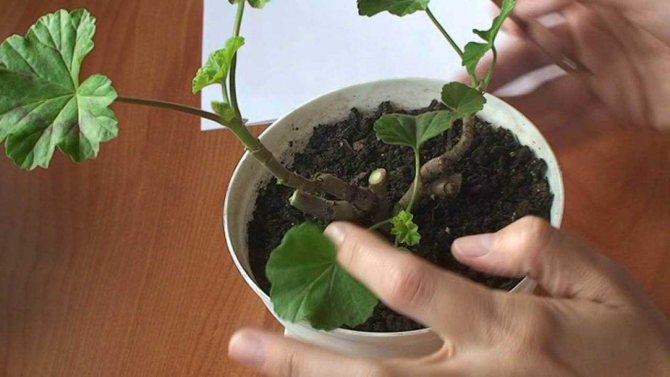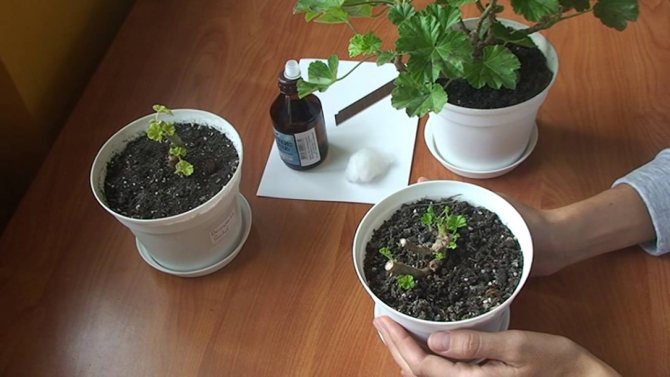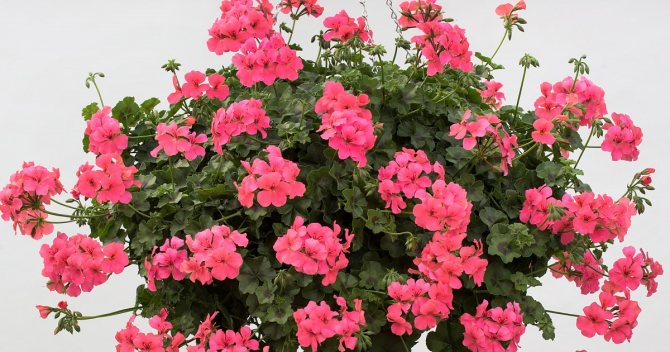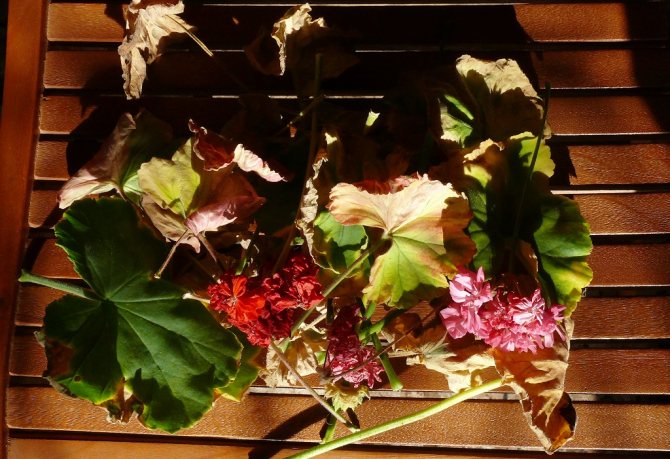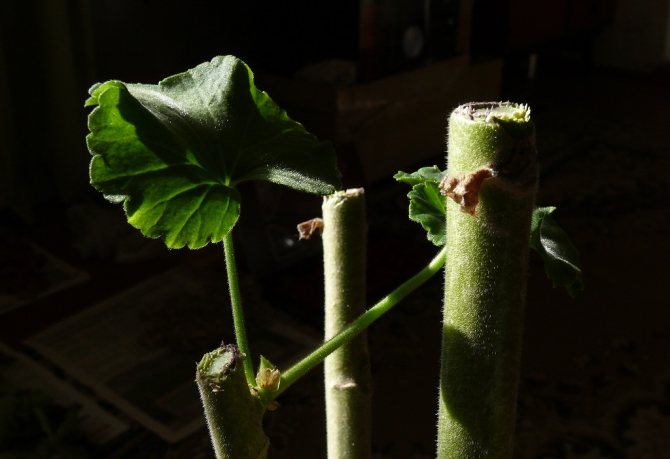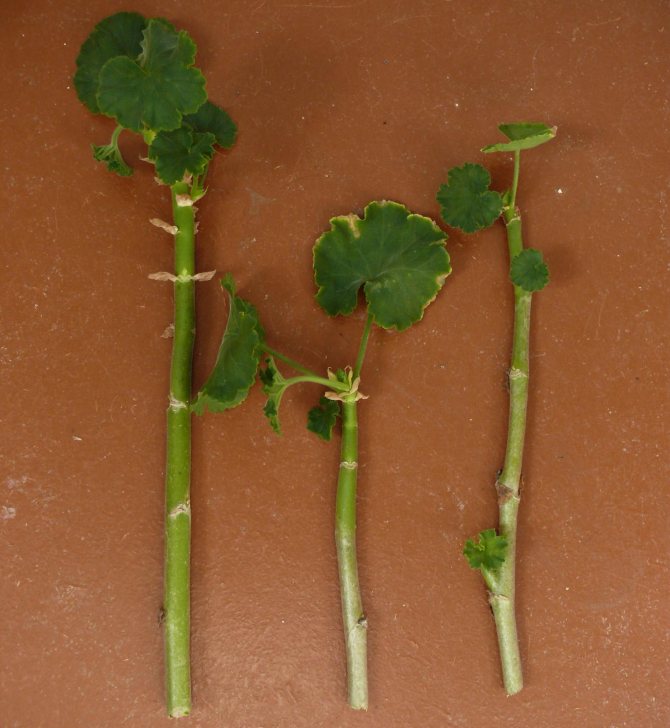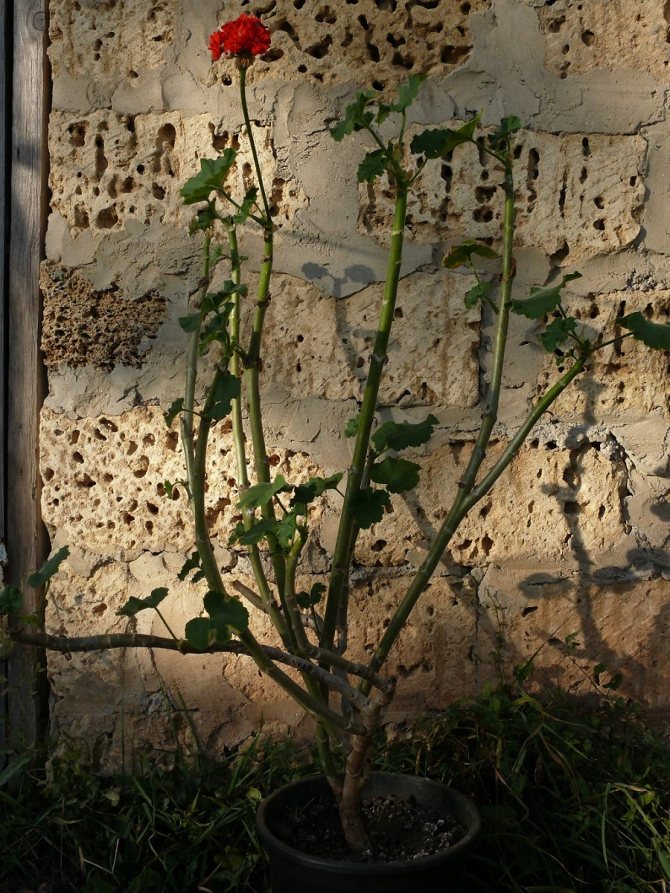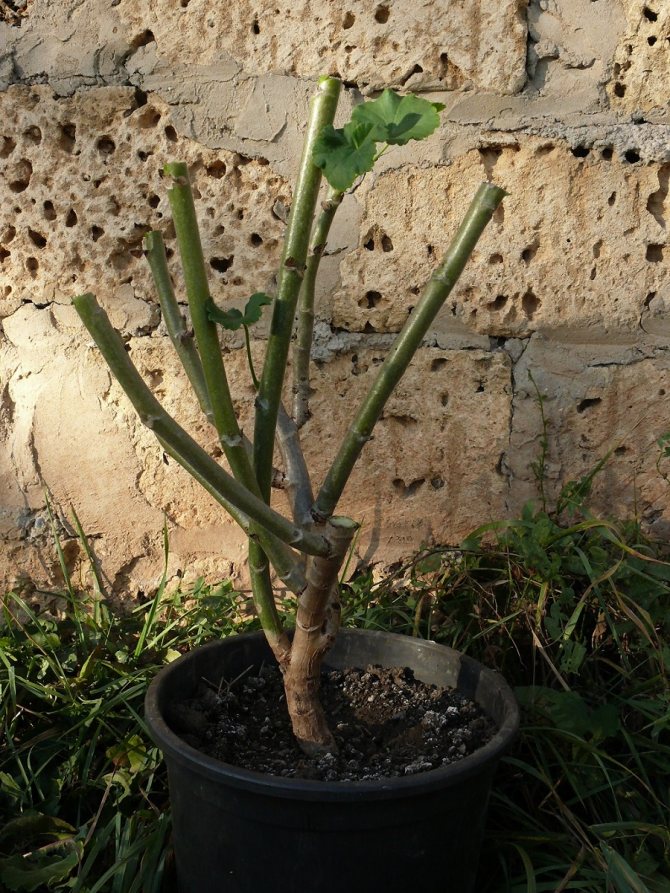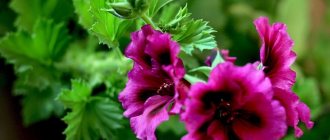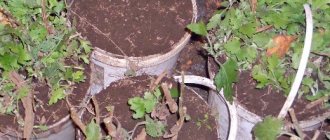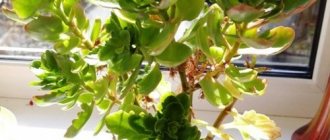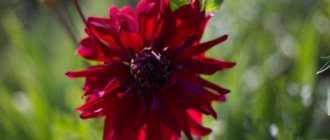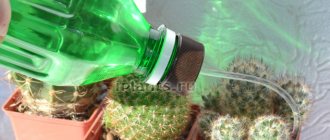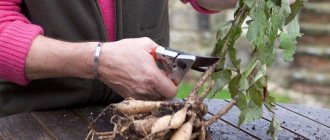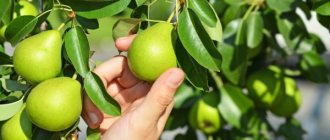Beauty and riot of colors!
Pelargonium (popularly - geranium) got its name from the unusual shape of the fruit, which resembles the beak of a crane. From the Greek language "geranios" is translated as "crane"... To date, over four hundred varieties of geraniums are known, but only about a hundred species grow and are safely grown on the territory of Russia.
On the windowsills of residential buildings and offices, you can find a wide variety of types of indoor geraniums, which differ from each other in the shape and size of leaves, inflorescences and color. Among the many types, six of the most popular can be distinguished:
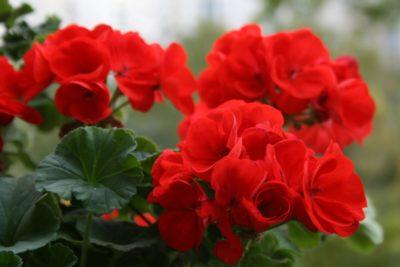
Angel - gives a pleasant aroma and pleases with a long flowering period.- Ampelskaya - differs in the presence of long branches, so it is more suitable for planting in hanging pots.
- Royal (royal, Martha Washington, noble, home) - differs in the presence of a dark spot located on each petal of a large flower.
- Fragrant - has a persistent aroma. Different varieties have different aromas - rose, wormwood, lemon, vanilla.
- Zonal - flowers have a double color with a sharp and clear transition.
- Gorgeous (blood red, garden) - suitable not only for planting at home, but also in the garden. It has a strong root system.
With proper and constant care, geraniums will bloom constantly and violently, increasing the number of inflorescences each year. But what is meant by proper care?
How to feed geraniums for lush flowering
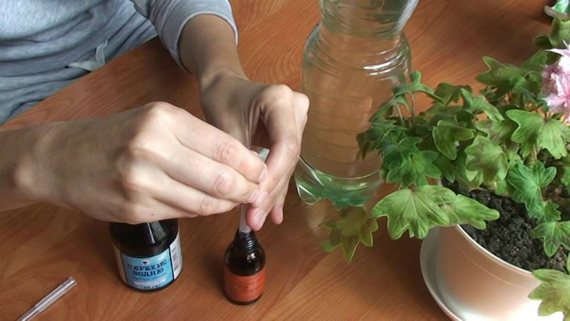

As spring approaches, geraniums begin to awaken and prepare for the flowering period intended by nature. And for it to be rich, long-lasting and luxurious, pelargonium will need a lot of nutrients.
- The first feeding after pruning is carried out with nitrogen-containing fertilizers to stimulate the growth of the green mass of the plant and the development of the root system.
- During the budding period, preference is given to phosphorus fertilizing.
- Potash fertilizers are applied to protect the plant from external factors and to stimulate the duration of flowering.
These are the three main elements that ensure the full development of geraniums. But to saturate the flowers with brightness and to maintain the foliage in a healthy state, the plant requires additional trace elements.
Complex fertilizers
Horticultural centers are full of colorful labels of balanced compositions for any type of plant. "MultiFlora Aqua", "BioMaster", "Gumi Omi" - contain in an accessible form iron, cobalt, boron, copper, zinc, manganese, molybdenum and humic acids.
Folk remedies
However, there are many folk remedies to stimulate the abundant and lush flowering of geraniums at home.
Iodine... The available product from the home first aid kit helps to accelerate the formation of buds and significantly increase their number. To prepare a solution, dissolve 1 drop of iodine in one liter of water. Watering is carried out on wet soil at the rate of 50 ml per root.
Milk mixture and 100 ml of milk and 1 liter of water will protect home geraniums from diseases. Such watering alternates with watering with clean water.
Baker's yeast contribute to the active development of the root system and the growth of green mass as a result of the formation of nitrogen and potassium in the soil. To prepare the composition, you will need 20 g of yeast and 1 liter of warm water. The solution is left to ferment for 2-3 hours and brought to a volume of 6 liters. Top dressing is carried out 2-3 times with a frequency of 7-10 days.
On a note. Top dressing of geraniums with industrial preparations is carried out only on wet soil and with a frequency of 2-3 weeks.
It will be useful to heed the advice of experienced gardeners on growing geraniums at home.
Why is the correction of the shape of the plant needed?
Regardless of which flower you are dealing with - indoor or garden - you need to prune geraniums from the very beginning of its planting... Depending on the species, the branches of the plant can be long - lodging or erect, as well as short and sloppy.
To give the flower the desired shape, you need to systematically monitor the newly emerging shoots and prune in time.
Despite the fact that geranium is very unpretentious, it is not able to independently give side shoots, although there are plenty of sleeping buds on them - they are located in each node.
Pruning contributes not only to the formation of a beautiful shape, but also activates the growth of new side shoots and promotes the emergence of new inflorescences of buds. Thus, the plant will gain strength and every year its flowering will be more lush and longer.
Such a plant will not give good planting material for reproduction and may soon die. Therefore, pruning at home is one of the basic rules for caring for geraniums.
Read about how to care for geraniums at home here, and from this article you will learn about recommendations for caring for a plant in the open field.
How to remove faded geranium flowers
One of the main reasons why it is worth removing inflorescences that have faded is considered the aesthetic side of the issue. Dry "earrings" do not decorate flowers.
However, timely removal of faded inflorescences can stimulate the growth of new ones.
It is recommended to remove the bud immediately after it starts to wither.
You can notice this by the petals, which change color, become covered with brownish spots. It is important not to miss this moment, because if you hesitate, you can wait for the formation of seeds.
It is worth removing by cutting with sharp scissors, not necessarily the entire inflorescence at once, you can one flower at a time as they dry.
Another important advantage of timely removal is the prevention of the formation and development of fungal diseases. The latter is especially important in the case of high humidity levels.
How to prune geraniums correctly: step by step instructions?
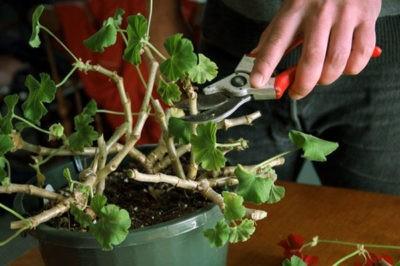

No unique tools are required for pruning geraniums... You will need a clerical knife (you can replace it with a blade or even a thin kitchen knife).
Scissors and secateurs are not suitable for this procedure, as they pinch the stem of the plant where it is cut. Before trimming, the instrument should be treated with a disinfectant solution so as not to introduce infection into a fresh wound.
Ordinary ethyl alcohol can serve as such a solution. Alternatively, you can boil the instrument for a few minutes.
Pruning geraniums should be done on time - not too often, but not at long intervals, and at suitable times of the year. You cannot cut off many shoots at a time, or carry out this procedure in the winter, but is it possible to cut geraniums in the summer? Geranium is pruned in spring and autumn... But here, too, there are some differences, which must be remembered when planning to ennoble the plant.
Watch a video on the correct pruning of room geranium (pelargonium):
Shaping in Spring
Before proceeding with the procedure for pinching geraniums, you should examine it well and carefully consider the desired flower shape. Having prepared the tools and processed them, you can safely get to work.
- Remove yellowed and dry leaves by hand, carefully cut weak and injured branches.
- Gradually cut off the side stems, leaving the sturdiest and strongest.
- Remove the side lower shoots from the remaining stem.
- If the stem is too tall, you need to carefully remove some of the top.
- If the stems are crooked and long, they need to be cut, leaving only 10 cm. After a few weeks, young leaves will appear in the place of these stumps.
- When preserving the bud on adjacent stems, it is important to pay attention to the direction of its growth - it should be opposite to the main stem.
- Apply disinfectants to the cut sites - wood ash, ground cinnamon, crushed activated carbon.
After pruning geraniums in the spring, it will give new inflorescences a few months later than when this procedure is carried out in the fall, since the plant will recover longer. If pinching is needed in the spring months, you can remove up to 20% of the shoots to keep it lush. Abundant pruning can affect the timing of the next geranium flowering, moving it all the way down to next season.
Autumn pinching
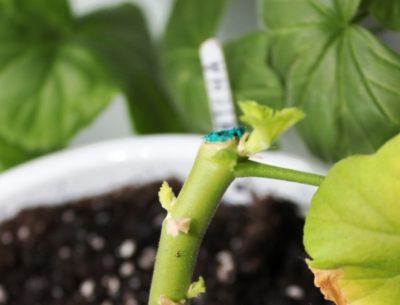

Autumn pinching is the best option, as the plant will take less time to recuperate. Slices are made with a sharp disinfected knife at an angle of 45-60 degrees directly 5 mm above the sheet node.
You need to trim only those nodes that have a growth direction opposite to the main stem.... New shoots from such buds will not grow up, but will be directed to the sides, which will prevent thickening of the crown.
Before starting work, you need to prepare the tools and carefully examine the flower, having studied its shape and the location of the stems.
- All cuts are made only over the leaf assembly. Shoots growing inside the bush, crossing or withered - are immediately removed.
- The outer stems are cut first so that you can get to the center. If you need to cut a lot of stems, then it is better to carry out this procedure in several passes with an interval of 2-3 weeks. So the plant will be able to restore strength every time before a new pinch.
- For the formation of new peduncles, it is necessary to trim the tips of the stems, leaving 4-5 leaf nodes.
- Apply ash, crushed activated carbon or crushed cinnamon to fresh wounds - they have disinfecting properties.
- To support the flower, apply fertilizers with nitrogen content to the soil (read about the composition of the soil for room geranium, whether a universal soil is suitable, read here). Provide enough light and warmth for the upcoming winter (you can find out how to care for home geraniums in order to preserve them in the winter and whether it is possible to transfer a garden flower to the basement here).
Read also Rake tedders trailed on a tractor
Such pruning procedures are carried out so that the plant feels comfortable, always delights the owners with greenery and bright flowers. If the purpose of pruning was to form a certain crown shape, then it is important to take into account several features.
Watch a video about the autumn pinching of geranium (pelargonium):
How to achieve lush bloom?
The frequency and duration of flowering of a home geranium depends on its type, on the conditions in which it grows, and, of course, when the pruning is done. To make it fluffy, you need to prune geraniums in the fall..
If the stems are stretched out too much during the winter, do not touch them.At the end of February, you can shorten them by only 2/3 of the total length, and in the spring you can pinch them.
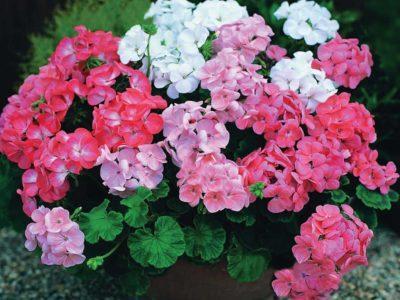

If we are talking about a large and dense plant, then you cannot cut off many stems at once, since all the strength of the flower will go to the restoration of stems and leaves. It is enough just to shorten the stems that have been knocked out, so that the flower regains its beautiful shape.
A lush bush is obtained with constant care and systematic pinching.... If you need to achieve lush leaves, then you need to trim the outer stems under the hemp, leaving them small - 7-10 cm.
Then the flower will be able to give new inflorescences, and new young leaves will appear in the place of the stumps. In the future, you just need to shorten the long stems just above the leaf nodule, from which young shoots and leaves will then go.
Formation of a standard tree
First of all, you need to remove the side shoots, and fix the central stem in several places to a vertical support.
You can cut off the shoot only when it exceeds the height of the support... Due to frequent pinching, the central trunk will branch out, which will allow to form a lush crown in the future.
Why geranium haircut
Every spring, we can observe how bushes and trees are trimmed on the central streets of the city, giving them the correct shape. But few people realize that this haircut is not only decorative. Plants are pruned for the sake of healing and rejuvenating the crown. The same applies to indoor specimens prone to intensive growth, such as pelargonium (geranium).
The purpose and benefits of pruning
The main purpose of pruning any plant is to thin the crown to improve air exchange, lighting and leaf nutrition. Without this event, the geranium will look neglected and unhealthy, stop blooming, turn into a shapeless and unkempt bush.
- the flowering period is extended;
- metabolism accelerates and its quality increases;
- more lateral branches and young shoots are formed;
- wintering is facilitated.
The flowering time of geraniums depends on the variety and runs from early spring to late autumn, and in some varieties even in winter. In order to have a lot of inflorescences on the plant, it is necessary to cut the bush, but do it correctly and in a timely manner, according to the characteristics of the variety.
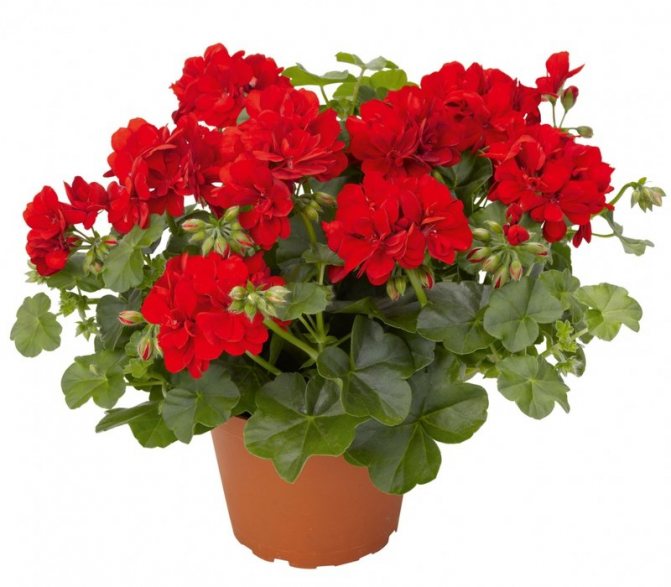

Geranium needs regular pruning to form a beautiful bush and lush color.
Autumn pruning is a more logical procedure than spring pruning. From November to February, geraniums begin a dormant period. The plant often slows down its development while continuing to feed. It is very difficult to maintain a lush crown in this state, while a haircut makes wintering much easier. Cardinal pruning allows pelargonium to refresh the crown and re-form the bush.
If your pelargonium blooms all year round, then you can cut it at any time.
In winter, it is possible to trim geraniums only if there are conditions for keeping a trimmed flower, leaving at least two lower leaves. After the crown of the plant is rejuvenated due to cardinal pruning, you can form its bush during the winter by pinching and decorative pruning. Zonal pelargonium has the peculiarity of fast budding and early bud formation, so she will only be happy with a haircut;
- ivy-leaved pelargonium can be cut in spring and autumn. If the bush stretches too much during the winter, it is trimmed in late February - early March;
- flower growers cut ampel geranium at their discretion, if the plant does not need pruning, then it is not touched until spring;
- the variegated species is difficult to tolerate autumn pruning, it is easier for them to go through such stress in the spring;
- mini-varieties of geraniums are not cut at all. The crown of these tiny pelargoniums is adjusted only for reasons of beauty and decorativeness of the bush;
- Royal Pelargonium is trimmed "under a stump" and placed in a cool place.But such a radical haircut is not done regularly, but if necessary, because the plant does not develop as intensively as, for example, zonal geranium.
Photo gallery: geranium varieties
Video: crown formation in geraniums in winter
Further care
After trimming, home care is necessary: fresh geranium wounds must be sprinkled with wood ash or activated carbon... Minimum watering will be optimal, as the amount of foliage has decreased significantly, which promotes long-term evaporation.
Feeding with nitrogen fertilizers will not be superfluous, which will help to recover from stress and activate the growth of new shoots (read about what is better to feed and when to use fertilizers, and from this article you will learn how to properly use iodine with hydrogen peroxide for beautiful flowering). Each plant needs to be looked after.
Geranium, being unpretentious in terms of watering and climate, requires constant attention and systematic pruning. The shape of the bush, the duration and frequency of flowering directly depend on how frequent and competent the pruning will be.
If you find an error, please select a piece of text and press Ctrl + Enter.
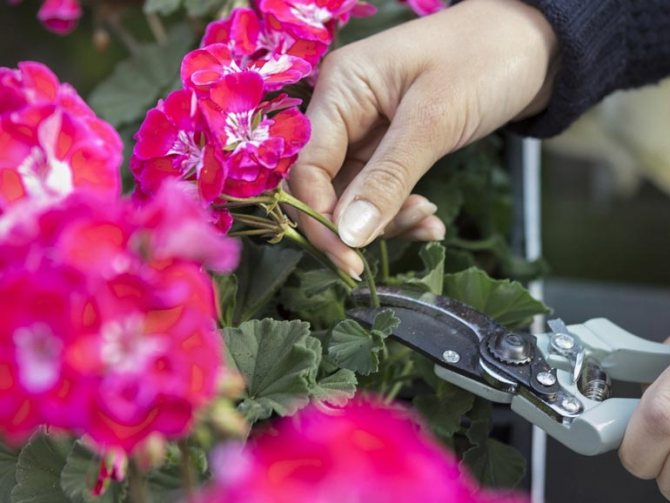

The unpretentious geranium is a home flowering plant. For many years, it has been popular among indoor flower lovers. They are also beautiful balcony flowers often found on terraces, balconies, or garden beds.
They require proper care to grow properly. In addition to fertilizing and watering, the plant should be pruned regularly. Pruning geraniums for lush flowering is an important step in the care. It prevents stretching, makes the crown fluffy and very beautiful.
Preparatory work before pruning
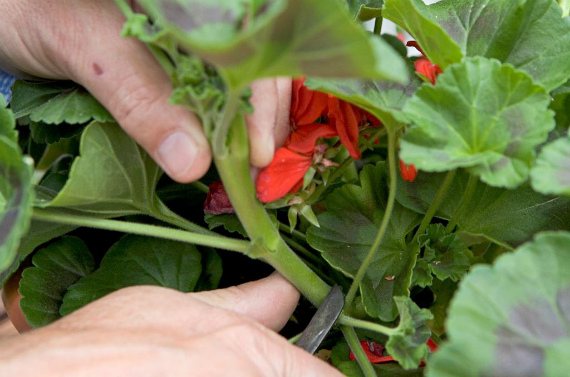

For the procedure, you will need a clerical knife or blade. It is not advisable to use scissors (although at first glance, this is the most suitable tool) - they pinch the stem at the cut point.
You will need some disinfectant to clean the cutter. You can use alcohol, vodka, or 3-5 minutes of boiling equipment. This is necessary in order not to introduce infection into the wounds (and there will be many of them).
To protect the cuts from external factors, it is recommended to use crushed charcoal or activated carbon.
Dried and yellow leaves are removed from the plant and, in fact, pruning begins.
The purpose and benefits of pruning
The species diversity of geraniums is amazing. She feels great both at home and outdoors. Correct pruning procedure guarantees regular flowering with a large number of inflorescences. When starting to form a plant, it is important to know how to properly prune geraniums, how to form a bush. Detailed answers to these questions are given below.
Goals for pinching geraniums:
- activation of lateral branching;
- the formation of new inflorescences;
- giving geranium a beautiful shape;
- ensuring long-term flowering;
- obtaining seedlings for reproduction.


Correct and timely pinching of geraniums allows you to activate the lateral vegetative buds. Without assistance, they will remain dormant. After pruning pelargonium, lateral buds begin not only to form new shoots, but also take part in the laying of the buds of inflorescences.
When pruning geraniums:
- in spring - the main type of pruning, which is necessary for volumetric flowering;
- in the fall - a preventive procedure to remove dead, diseased and dry parts;
- pinching is a type of pruning that can be carried out at any time if the need arises.
Important! Pruning geraniums should be regular so that it blooms on time. Otherwise, flowering may be delayed or not occur at all.
Why prune geraniums?
Systematic pruning of pelargonium allows the plant to retain the strength to grow healthy shoots. By pruning, you can achieve lush flowering over a long period. Removing and limiting the growth of shoots stimulates the development of the plant in a certain direction, creating the desired shape. Also, a fairly thinned geranium bush becomes less susceptible to fungal diseases.
Rooting of cut shoots is not the purpose of pruning, but is another advantage of the procedure.
Pruning can also revive withering geraniums. If, after pruning, the stem remains green when cut, new leaves will appear within a few weeks.
Important! The procedure will bring the desired result only if you follow the technique and work with a disinfected instrument.
Crown formation in winter
The winter months for geraniums are dormant times. Short daylight hours and lack of solar energy send this indoor flower to hibernation.
- does not bloom;
- does not give active growth;
- does not form new shoots.
As a rule, there is no need for pruning in winter. During this period, you need to monitor the state of the geranium. Particular attention should be paid to shoots that were pruned in the fall. If the cut points began to turn black or rot, then the diseased area should be cut off.
If there is a need, then the time for the main pruning can be postponed to the second half of February. However, if possible, it is better to postpone this procedure until March.
Before the onset of winter, it is recommended to tame all the shoots by at least 1/3. This allows the kidneys that are inactive to be activated. This procedure has a beneficial effect on the formation of geraniums.
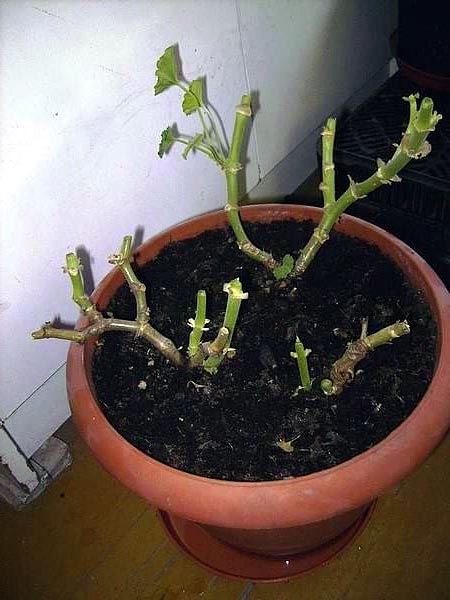

Pruning features
In plant growing, several favorable periods are known for thinning geraniums. These are the so-called spring, autumn and winter haircuts. Despite the fact that such a procedure always has a beneficial effect on the flower, it should be approached with caution - excessive and untimely pruning can cause inhibition of plant growth.
In autumn
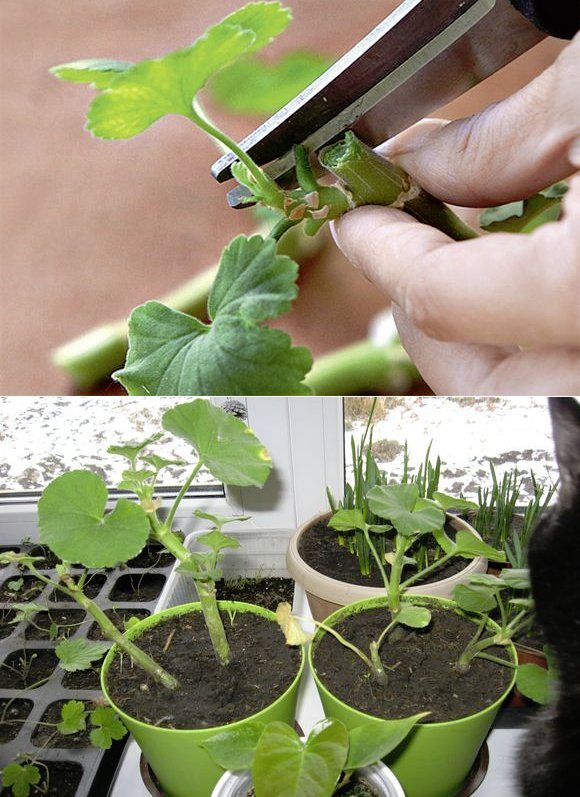

Autumn haircut is the most important stage in the life cycle of a species. It is often carried out at the end of September after the first yellowed leaves appear on the plant. After flowering and seed formation, geraniums have a dormant period.
At this time, it slows down its growth and metabolism, and with this - the amount of nutrients absorbed from the soil. Eliminating the extra crown before hibernation helps the flower to use its own forces more rationally and avoid unnecessary waste of accumulated resources on maintaining non-viable shoots.
Thanks to this, geraniums are able to more comfortably endure hibernation, as well as avoid excessive stress. The procedure also makes it possible to activate the most viable buds, due to which shoots resistant to various factors and environmental challenges grow.
Do not forget that pruning in the fall often helps to remove parts of plants affected by infections and pests, which is quite important in the conditions of growing a monoculture in a limited area.
In winter
Pruning in winter is carried out quite rarely, since during this period there is a sharp weakening of the protective functions of the flower's body. But if you want to create a really beautiful bush, then you cannot do without it, otherwise it will take at least 1 season in order to adjust the shape of the geranium to the optimal one.
Pruning is carried out as young shoots grow, by pinching the tops and eliminating the lateral branches. This helps to avoid over-stretching the flower and also helps to get it into the correct shape.
Important! From December to January, pruning is prohibited, since at this time the flower is most vulnerable to any external influences. Neglecting the recommendation can lead to his death.
The main condition for successful winter pruning is compliance with all plant maintenance requirements. The flower should be placed in the warmest and lightest corner of the house, as well as protected from drafts, cold and sudden changes in temperature. At the same time, gentle, but regular watering is carried out, otherwise geraniums can sharply negatively react to the procedure.
In the spring
In many horticultural circles, the question of the advisability of spring pruning is quite acute. Despite the fact that shortening the plant before the active growth phase is undesirable, many growers still resort to the procedure at this time.
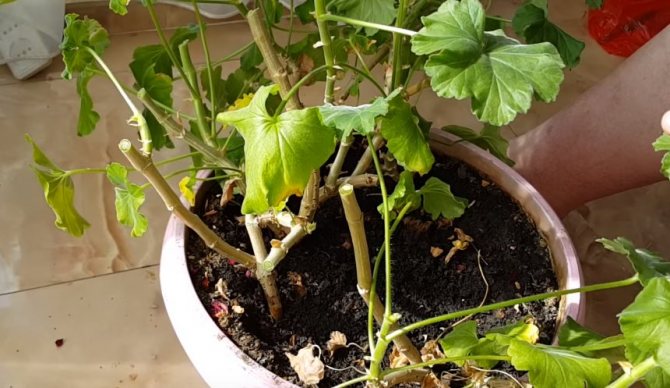

In the spring, the crown shape is given the final completeness, and non-viable shoots are also removed from the bush. However, in the case of intensive winter pruning, it is better to skip the spring procedure in order to avoid oppression of the geranium.
The most optimal period for spring pruning is considered to be in late February - early March. A later procedure can cause inhibition of the growth of geranium, as a result, this can lead to a weakening of the flower's immunity and its defeat by various infections. Therefore, pruning should be done with extreme caution.
Important! Geranium cut in spring always blooms a little later. This should be taken into account when growing it, especially early varieties.
How to form pelargonium in the fall?
Indoor plant lovers need to know how to prune geraniums in the fall. To get a good result, it is important to strictly follow the rules for pruning.
Step-by-step instruction:
- carefully consider the flower - it is necessary to determine which extra parts will be removed;
- all the tools with which the cut is made must be disinfected - boiled, calcined or treated with an alcohol solution;
- before the procedure, you must wash your hands well (preferably with soap) and wear silicone (rubber) gloves. This step is necessary to prevent the risk of contamination of the plant through the pinch site;
- remove all dry parts from the plant (old inflorescences, leaves, stems and twigs);
- remove parts that may become a source of disease or have a suspicious appearance;
- remove all stems that are too extended upward, these include shoots that have more than 5 vegetative buds;
- treat the places of removal with a special disinfectant solution.
Before pruning geraniums in the fall, you need to make sure that this procedure is necessary for it. Not all types of this houseplant tolerate the removal of parts well:
- royal geranium treats the autumn pinch well;
- ampelous or variegated do not really like this procedure.
Care after autumn pruning
After removing excess parts, the cut sites are treated with disinfectants. Suitable:
- coal powder;
- ground cinnamon;
- brilliant green solution.
Geranium does not require especially difficult care after seasonal pruning. It is necessary to monitor the condition of the places where the cut was made. If blackening or rot appears, then repeated removal and disinfection is carried out.
Indoor plant and tool preparation
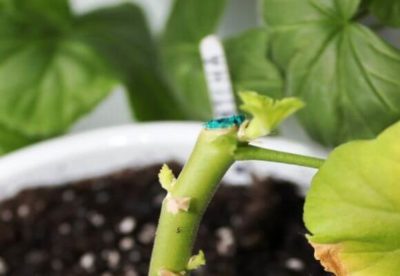

Before pruning, you need to prepare the tool and flower for the procedure.... This requires:
- clean geraniums from all dry, yellowing and fading leaves and flowers;
- disinfect the instrument with boiling water, alcohol or a special agent.
The best way to trim the flower is to use a blade, utility knife, or a thin-blade kitchen knife. Do not use scissors - they can crush the stem and disrupt the tissue structure at the cut site.
How to prune pelargonium in spring
Spring pruning of pelargonium is aimed at forming a beautiful and voluminous crown with a large number of bright flowers. The term for pruning is the last decade of February - early March.
The purpose and benefits of a spring haircut
At the beginning of the new growing season, first of all, excess, excessively long shoots are removed.They spoil the aesthetics of the plant and do not give the desired flowering.
In the spring, a beautiful pelargonium bush is formed, which will delight with beautiful flowering throughout the summer.
Important! Spring pruning is recommended as early as possible, it depends on the timing of when generative (flower) buds begin to form.
Step-by-step instructions for spring pruning
- prepare inventory and tools for the procedure - scissors, pruning shears, knife;
- sterilize instruments;
- wash and treat hands, wear gloves;
- inspect the plant from all sides and determine the direction of work;
- remove dry parts of the plant - branches and leaves;
- choose the main stem of the plant, remove the lower young shoots on it;
- remove all lateral processes and other stems, leave only the main one;
- the top of the central stem must be pinched to activate branching;
- treat the places where plant parts are removed with antiseptic preparations (coal powder, brilliant green, ground cinnamon).
Important! It is necessary to pinch the houseplant correctly to form a tree-like shape.
Leaving after spring pruning
After the formation of the crown of a given plant, it is important to provide it with proper care. It will accelerate the growth process and the beginning of flowering.
- watering every 3 days;
- protection from cold and drafts;
- fertilizing with mineral fertilizers once every 30 days.
Read also Horse racing of different ages and strengths
Geranium has faded, what to do
In case you wish to stimulate further flowering, cut the flowers before they dry. The main goal of geranium is to form, as a result of flowering, seeds, if this cannot be achieved, flowering is repeated.
It is also important to consider that the plant takes too much energy to develop seeds. The nutrients that could go to the growth and development of the flower go to the formation of seeds.
In the process, flowering either completely stops or is minimized.
Timely cut buds help to activate the process of re-formation of new ones. In addition, it helps to reduce the level of energy losses.
How to form a fluffy pelargonium bush, the essence of pinching
How to pinch geraniums so that it grows thicker and if the plant is elongated, what to do? These questions are often asked by geranium breeders.
Pinching is the removal of the apex of a houseplant. If the geranium does not have the opportunity to grow up, then it will begin to actively develop lateral shoots and branching. This will form a beautiful and lush crown.
The form of pelargonium, in which one main stem with a voluminous crown develops, is called standard.
To create such an unusual appearance, you must:
- remove extra stems and extra side branches;
- regularly inspect the plant for the formation of excess parts and remove them in a timely manner.
The pinching technique is used for plants that have just begun their growth. Regular removal of the apical growth points ensures the appearance of a beautiful spherical crown.
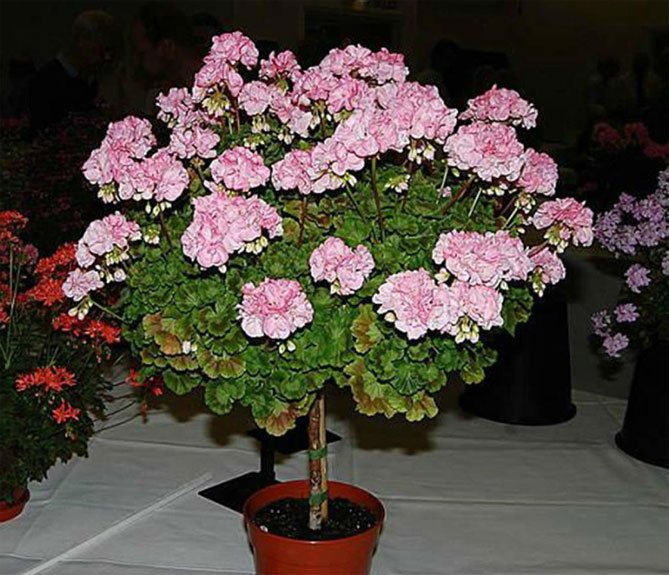

Preparing for wintering: pruning
Preparation for the dormant period begins in the fall, and the most important thing to do is to prune geraniums. This will ultimately make a huge difference in how it blooms. Without pruning, even if all the necessary conditions set out below are met, such lush and beautiful flowers will not appear on the plant.
Geranium pruning procedure:
- At the end of September, absolutely all flower stalks are cut, regardless of whether they have faded or are still actively doing it. This is done in order to help geraniums conserve their resource reserves for the winter.
- All the leaves that have already turned yellow and withered or have just begun to do so are pinched off or cut off. Experienced growers recommend pinching them off rather than cutting them off with scissors.In the second case, there are mere protruding roots.
- For dense flowering in September, geraniums are cut so that the beginning of branching remains, or slightly higher (3 - 5 cm) of the node. The top cut can be rooted like a cutting.
You need to prune the plant until it loses its beautiful and lush appearance. If the plant is young, then only
, and do it according to the following rules:
- The pinching of young plants begins when their height reaches 5 - 6 cm.
- After the geranium grows another 5 cm, pinching is done again.
- To achieve a spherical shape, you can pinch 3 times in the same way.
Knowing how to properly handle geraniums during its dormant period, you can not be afraid that it will not bloom in the summer. And absolutely everyone can provide these conditions for this, regardless of their floriculture skills.
If you find an error, please select a piece of text and press Ctrl + Enter
.
The last summer month has ended, on the threshold of September, the time for preparing pelargoniums for winter rest. Pelargoniums have grown over the summer in the dacha freedom, in someone on balconies and verandas. The beginning of September is the time for the pelargonium to move to an apartment or house, before the cold snaps, you need to bring the plants into the room. It is desirable that the temperatures in the room and on the street do not differ very sharply, it will be easier for pelargoniums to acclimate to new conditions. It is better to bring dwarf, miniature and variegated varieties first, then zonal and fragrant pelargoniums and the last royal and angels (they can remain on the glassed-in balcony until the end of September). In September, we reduce the frequency and volume of irrigation of pelargoniums, we reduce the dose of applied fertilizers, and after 2-3 weeks we do not apply fertilizers at all.
If pelargonium is brought in at the end of September or October, during cold snaps, the plants may experience stress due to too abrupt changes in conditions of detention, the leaves of pelargoniums will begin to turn yellow and fall off, the later the move and the greater the temperature difference, the more the leaves turn yellow.
Yellowing of leaves in autumn in pelargoniums can be for the following reasons:
1 - they can adapt to new conditions after moving.
2 - in the fall, there is no energy to maintain dense foliage and pelargoniums are shedding excess.
3 - draft or cold air.
4 - violation of the irrigation regime - overflow, or overdrying of the earth.
Wintering pelargonium will not cause a problem if the following conditions are met:
Autumn pruning of pelargonium.
In early September, when the plants adapt, it is necessary to lightly prune the shoots of the zonal pelargoniums so that they have time to recover in the remaining light and warm time. The only exception is variegated varieties. They are very painful to tolerate pruning.
Royal pelargoniums need to be pruned in October-November, when they stop blooming.
Dwarf and miniature varieties practically do not need pruning.
Ivy-leaved varieties - highly overgrown varieties are pruned, leaving whips about 40-50 cm, the rest are easy pruning, and miniature varieties do without it.
If you are late with pruning ivy-leaved varieties, then it is better to carry it out closer to spring - in February. Pruning in late autumn can lead to the death of the plant and cuttings (especially if the plant is young or the variety is miniature), it should be borne in mind that pruning in winter weakens the plant greatly.
Preventive treatment of plants.
Be sure to treat the plants with "Fundazol" and drugs against pests, you can use "Actellik" or "Fitoverm".
Location and temperature conditions:
There are many recommendations and tips for placing pelargoniums for the winter, choose the ones that are suitable for your home and place the plants according to your conditions: temperature, light, humidity, and most importantly, free space ....it can be insulated balconies and verandas with temperatures up to +15 in winter (ideal conditions when the plants remain in their places), or window sills and shelves in the house.
Wintering on the windowsill.
Ivy-leaved, fragrant, zonal pelargoniums winter well on the windowsill with t + 10 .... 15, on cooler ones from t to + 10, royal pelargoniums, angels, they will bloom profusely only after a "cold" wintering. If the conditions on all the windowsills are approximately the same, then closer to the glass, where it is cooler, we place the plants for "cold" wintering, followed by the rest.
Wintering on a rack with fluorescent lamps.
Variegated and miniature varieties are most demanding on lighting. The best place for them, as well as for pelargonium cuttings, is a backlit rack. The distance between the tops of plants and lamps should be 10-15 cm, with additional lighting - at least 10-12 hours a day. With such a content, variegated varieties will not lose the beauty of their leaves, and miniature varieties will be better preserved, because their root system is weaker than that of ordinary varieties of zonal pelargoniums. Place the plants on the racks not too tightly to each other, water a little more (because the temperature in the rooms is +20 ... 25 ° C) than the varieties wintering on cool windowsills, preferably with warm water.
Compliance with the watering regime:
Pelargoniums are very sensitive and demanding for watering, especially with the onset of cold weather. In winter, it should be moderate and regular, waterlogged soil and high temperatures, or excess moisture and cold, too dense soil, can cause root or stem rot. The main reason for the black leg (the Pythium olebarium fungus affects the base of the stem and cuttings), most often problems: wilting, blanching or blackening of the stems are observed on young, tender shoots of pelargonium that did not have time to get stronger, therefore watering variegated, dwarf, miniature varieties, as well as cuttings with special attention. If the plant is infected, the only way to save the cultivar is to re-root a healthy apical stalk.
Autumn care for pelargoniums:
Gradually reduce watering and do not feed the plants until February pruning, loosen the topsoil to provide air access to the roots, regularly remove dried leaves, preventive treatments for pests are useful. Do not move plants from place to place unnecessarily, do not place them too close to the glass, so as not to freeze the leaves of the plants.
Geraniums are unpretentious and willingly flowering plants. And yet, if geranium appears, home care becomes the key to the duration of its flowering. It depends only on the care of the grower how long the external attractiveness of the plant will remain, how lush and bright the inflorescences will be.
For two hundred years of cultivation as indoor plants, geraniums have firmly entered the life of Russians. Pink, scarlet, white and variegated umbrella inflorescences of pelargoniums or geraniums can be seen on the windows of city apartments, in summer cottages on summer days and on the verandas of rural houses. The flower, which has become truly popular, is in fact a native of South Africa, for whom Russian conditions are not always comfortable.
In nature, wild geraniums are perennials:
- with powerful, weakly branching shoots;
- with smooth or slightly pubescent split leaves;
- with umbellate inflorescences, in which up to 20 individual flowers are collected.
The culture is valued for the massiveness and duration of flowering, which, with proper care for geraniums at home, lasts from spring to pre-winter. At the same time, many species are quite fragrant, and the docile nature of the plant is its great advantage.
In conditions of home keeping, decorative geranium varieties retain their decorative effect for at least 4–5 years. But properly organized care helps to extend the life of a flowering specimen up to ten years or more.How to care for a geranium so that it blooms, remains attractive and healthy for a long time?
The most common pruning mistakes
Geranium can be cut incorrectly and then the plant can get sick or even die. Most often, inexperienced growers make the following mistakes:
- pruning the plant at the wrong time;
- non-compliance with the recommendation for the height of the cut relative to the vegetative node;
- excessive removal of shoots;
- too frequent pruning.
As a result of these actions, the plant can stop blooming, acquire an ugly appearance, and also get sick or die.
In addition, many owners of pelargonium feed the plant incorrectly.
Proper feeding includes:
- immediately after pruning, it is recommended to feed geraniums with nitrogen mineral fertilizers;
- at the stage of active flowering and the appearance of a lush crown, the need for potassium increases.
Conclusion
Geranium or pelargonium is rightly appreciated by lovers of indoor plants and summer residents. Correct and timely pruning will help create a crown of amazing beauty. The plant will delight with abundant flowering every season. The procedure for removing excess parts is simple, but you must adhere to some rules. They will help to avoid mistakes that have an extremely negative effect on the condition of the plant.


Geranium is not for nothing that many gardeners love it. It is easy to care for, undemanding to soil and watering. But there is something that is necessary in the formation of a beautiful lush bush of pelargonium and its long-term flowering. This is pruning and pinching. If you do not perform these operations with geraniums in a timely manner, then very quickly the flower will lose its shape, bare shoots will stretch, and the number of inflorescences will come to naught. When and how to cut and shape the flower crown correctly? Here is what experienced geranium gardeners advise.
- 1 How to properly prune geraniums in the fall
- 2 Crown formation
- 3 Pruning: Necessary or Not Useful?
- 4 Mistakes when pruning geraniums at home
Why do geranium correction?
Pruning is one of the most important procedures in preparing indoor geraniums for winter. It makes it possible to rid the flower of unnecessary shoots and form the necessary shape of the bush. In addition, it helps to thin out the plant, thereby improving air exchange between the shoots and increasing their illumination.
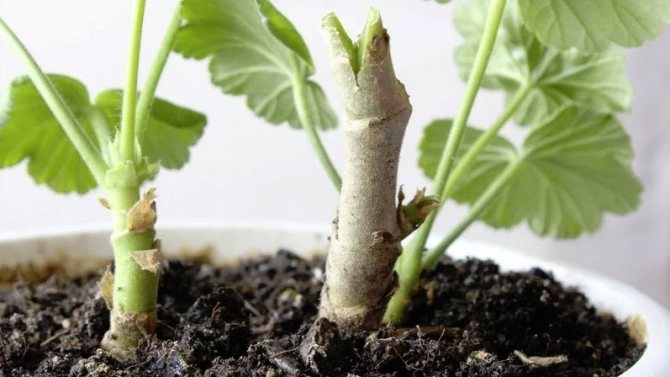

The end result is that a carefully pruned plant instantly produces new shoots on which young inflorescences and leaves develop. Thus, a haircut helps to maintain the vital activity of geraniums for 3 or more seasons.
In addition, subject to the seasonal haircut schedule, you can achieve:
- compact bush shape;
- an increase in the size of flowers and the duration of geranium flowering;
- increasing plant immunity during flowering and other periods.
Did you know? As an ornamental plant, geranium has been cultivated since the middle of the 16th century, after the flower left Africa on ships of seafarers and immigrated to the Old World.
How to prune geraniums correctly in the fall
The purpose of the autumn pruning
There are many varieties of geraniums: these are indoor or garden plants, with lodging or climbing stems, tall or undersized, bush or ampelous. For each flower, you need to choose your own pruning method, matching it with the desired shapes that you would like to give pelargonium.
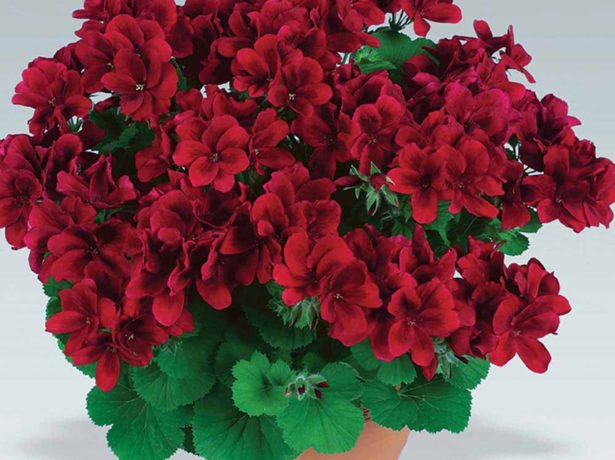

Geraniums need help to form a beautiful bush
The ultimate goal of pruning geraniums is to get a beautiful bush with lush blooming inflorescences. Accompanying - the improvement of the bush.
For all types of geraniums, it is important to adhere to the main requirement: pruning and control over the shape of the bush should be done regularly. It is impossible to cut once and get a conceived design. It is necessary to deal with the formation of a beautiful type of geranium constantly, starting immediately after its planting.You don't need to wait a year or two for the stems to grow long and bare, keeping only a few leaves at the very top. Pruning leads to increased growth of lateral shoots and stimulates the conception of new inflorescences.
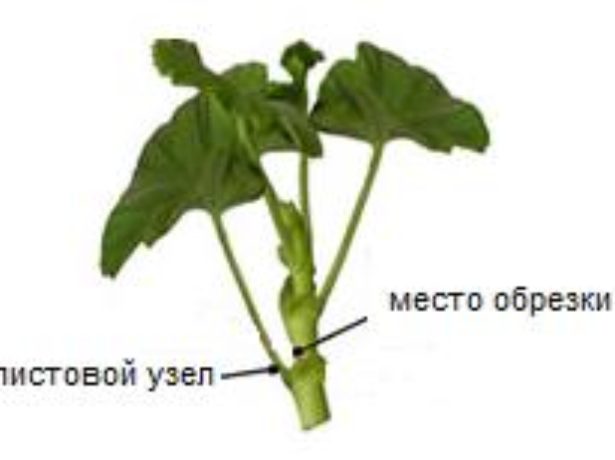

The Right Place to Cut Geranium Cuttings
Geranium itself does not emit additional lateral stems without human intervention. But dormant growth buds are located at each node. Their growth should be provoked. After pruning, the plant begins to grow compactly, without bare and ugly branches that pop out. In addition to lateral shoots, flower buds are also activated. Such geraniums bloom longer and more magnificently than their groomed counterparts. After flowering is complete, the bush gives high-quality planting material, which allows you to propagate your favorite pelargonium variety.
Time spending
Pelargonium is a smart plant. She herself will tell you when to start pruning. Geranium is pruned after the flowering stops on the bush and the last inflorescences wilted. If the plant is planted in the open ground for the summer or remains in the garden all year round, then half the height of the stem is removed. If the flower has spent the summer outdoors, before pruning it should be kept in the room for ten days so that it gets used to the new living conditions. Removing the excess crown improves air exchange, the lower leaves open up to a sunny color. This reduces the risk of fungal infections.
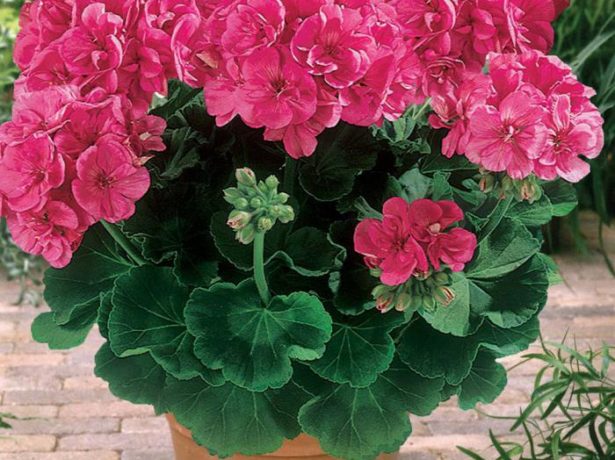

Formed flowering geranium bush
Winter is a dormant time for the plant, but not for the grower. It is necessary to monitor the state of the slices. If the cut has turned black, has become an unnatural color, it is necessary to repeat the pruning, removing the non-healing wound on the stem.
Features of the procedure for different types of pelargonium
You can determine whether a particular plant needs pruning by its appearance. If the bush is compact, the branches are neat, then the pruning can be postponed until spring. For example, zonal geraniums often grow obscenely, flaunting a trunk uncovered by leaves. Then, of course, pruning is a must. Ampel Pelargonium is beautiful with long shoots, but decorated with foliage and flowers. If the type of plant is quite presentable, then it is better not to touch the bush until spring.
Variegated geraniums experience a lot of stress after pruning, so if you don't have to trim, don't do it. There is an interesting variety - mini-pelargonium. The name itself indicates their miniature size. Therefore, pruning is a rare event for them. Unless only to remove something suddenly protruding from the overall compact design. King geraniums need pruning after the growth of the bush. In the fall, they cut off all that is superfluous, leaving only a small shoot with buds.
Scheme of work
It is necessary to remove geranium shoots with a disinfected tool. This is a sharp knife (kitchen or clerical) or blade. Scissors will not work for this procedure, as they pinch the stem. Cut off the trunk of the geranium above the leaf node in three to five millimeters. The cut is made at an acute angle. You should choose nodules aimed at the outside of the bush. With the growth of shoots from such a bud, the shoots will not lead to thickening of the crown, since they will strive to separate from the center of the bush.
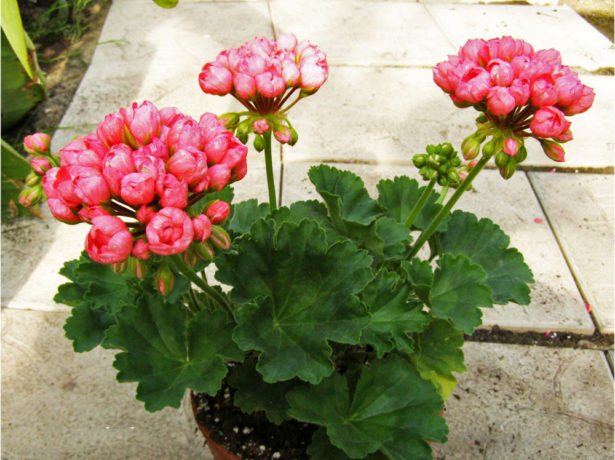

The preserved shoots with the direction of growth from the center do not lead to thickening of the crown
Step-by-step instructions for autumn pruning geranium
Video tip
Features of caring for geraniums after pruning
The place where the geranium stem is cut must be disinfected. For this, activated carbon is suitable. It needs to be crushed into powder, and then sprinkled on the cut site. Another remedy is wood ash. It is also a good antiseptic. Cinnamon powder is considered to be a natural wound healing stimulant. They can also process a slice.
Read also Why do geese and ducks dream
The treated plant must be fed with nitrogen fertilizers. This vitamin complex will help cope with stress and stimulate the growth of shoots and greenery.
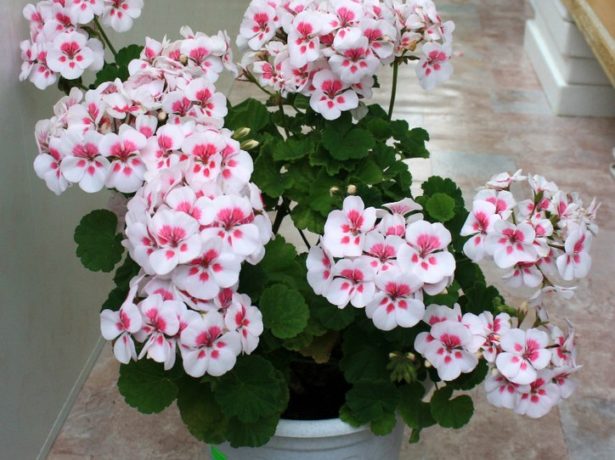

For the splendor of greenery and flowers, the plant must be fed
Watering should be reduced. Since there will be very little green mass left, excess moisture will not be able to evaporate. This can lead to disease and death of the plant. It is already weakened by the experience experienced.
Wintering conditions: table
| Geranium keeping conditions | Required indicators |
| Temperature | During the day - 18-20 degrees, at night - 12-15 degrees. For royal geranium, +10 and +4, respectively. |
| Light mode | South windowsill or additional lighting with a lamp up to 12 hours a day |
| Watering | Two to three times a week. The need for watering is determined by the dried topsoil in the pot. |
| Top dressing | Immediately after pruning with nitrogen fertilizers. This should be enough for the whole winter. |
Is it possible to prune blooming geraniums
This question worries gardeners, because often the flowering period for plants is not the best time for active activities with them. Geranium, despite its durability and unpretentiousness, is no exception. It is best to wait for the plant to bloom and then move on to action.
However, if there is no choice, you can prune, but no more than a few branches. The loss of a larger amount can negatively affect the condition of the flower, its appearance. After trimming, it is imperative to treat the cut points with activated carbon. Moreover, if the cut branch has a bud, it must be removed so that it does not interfere with the rooting of the cutting.
Cutting off shoots for seedlings during flowering is possible, but not desirable. It is better to wait until the plant has bloomed and proceed with the planned pruning, then you can prepare a huge number of young seedlings for further reproduction without harm to the mother plant.
Crown formation
It is necessary to form the crown of the geranium almost immediately after planting the cuttings. The main actions to achieve this goal are pruning and pinching. If the geranium is pruned in the fall, then in the spring you can prune or pinch it. What is the difference? Pinching is the removal of a plant's point of growth. In its absence, geranium throws out side shoots and turns into a small branched tree. The first pinching is done over 8 or 10 leaves. The time of its holding is the end of February-March. Lateral shoots are also pinched as they grow. It is not worth delaying the spring manipulations with geraniums. The later the pinching is carried out, the longer the time until the flowers appear.
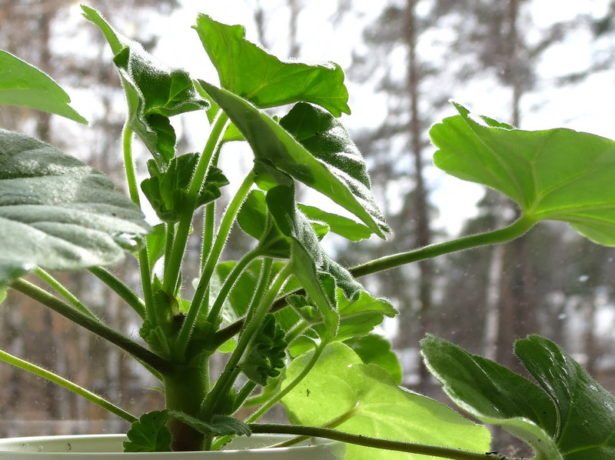

Pinching young shoots accelerates the growth of lateral shoots
Spring pruning is a cut of large stems at the level of the second or fifth leaf from the root. The time of the operation is autumn or early spring.
The basics of correct crown formation
- Carry out all manipulations with geraniums only with processed tools and clean hands.
- First of all, remove (cut or pinch) the shoots growing inside the bush to prevent thickening.
- With a large distance between the pairs of leaves, the stem is cut off immediately above the leaves, making an indent of up to five millimeters.
- First of all, diseased shoots are removed, capturing up to five centimeters of the healthy part.
Step-by-step instructions for spring procedures
Spring work with geraniums is very similar to autumn pruning. The first three steps are exactly the same. But it also has its own nuances.
- Carefully examine the plant and think carefully about how you would like to get the result.
- Remove any yellowed or damaged twigs and leaves.
- Prepare tools. You will need a sharp knife, blade, in extreme cases, pruning shears or scissors. You can disinfect tools with alcohol by wiping their working surface. Another way: ignite over a flame or boil in water for 10-15 minutes. To pinch, wash your hands thoroughly.
- Cut off all the stems, leaving the healthiest and most beautiful one. It is necessary to remove the lower side shoots from it.
- A stem that is too high must be shortened by removing part of the top.Side buds will grow and the geranium will turn into a small tree on a trunk (or a ball on a stick).
- Pelargonium stems that are too long or crooked can be trimmed, leaving stumps up to ten centimeters. After a few weeks, fluffy bushes will appear in the pot instead.
- Pay attention to the direction of the kidney's growth. It should tend to grow in the opposite direction from the main stem.
- Treat the sections with a disinfectant (ash, coal, cinnamon, alcohol solution).
Geranium crown formation (video)
Spring pruning and pinching perform an important agrotechnical function - they stimulate the formation of new buds, branches and inflorescences.
It is important to remember: after spring pruning and / or pinching, geraniums will bloom later.
The explanation for this is simple, the flower needs time to recuperate. Therefore, you need to decide what you want to achieve: early flowering or its splendor and durability. If you consider that pinching is a more gentle procedure than pruning, then in the spring you can stop at the first option. It is necessary to pinch young shoots not only in spring, but also as the plant grows.
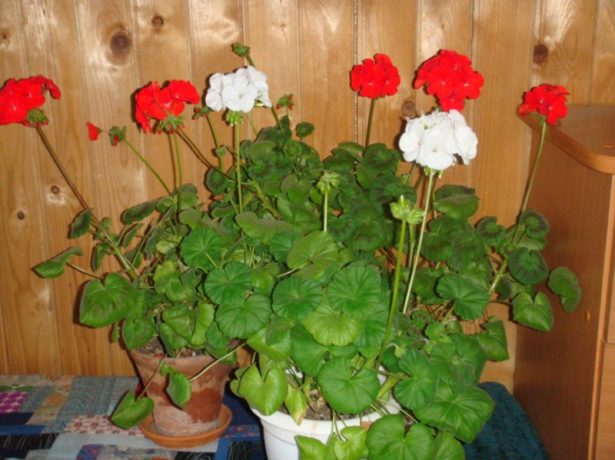

Geranium needs constant control of the grower for the growth of shoots and the removal of unnecessary shoots
Without an urgent need, pruning in the spring can be omitted. You can only cut up to 20% of all shoots. Large thinning can significantly shift the flowering time. Also, the plant can spend all its strength on recovering from stress and not bloom at all this season.
Care after work: table
Geraniums that have undergone spring pinching or pruning need the most favorable conditions for keeping.
| Geranium keeping conditions | Required indicators |
| Temperature | Comfortable temperature is above +12 degrees. Can be exposed to fresh air at night temperatures of +4 degrees. |
| Light mode | South side of the house. Geranium is very fond of the sun and tolerates direct sunlight well. Doesn't like drafts. |
| Watering | Water in a day or two. You can check the need for watering by the top dry layer of soil. |
| Air humidity | In no case should you spray the plant. This is dangerous for geraniums. |
| Top dressing | Loves nitrogen, phosphorus and potassium. It is necessary to bring in once or twice a month. You can buy ready-made fertilizers "For flowering plants". Does not tolerate organic fertilizers (fresh manure). |
Features of caring for geraniums after pruning
Flowers that have undergone autumn molding pruning need additional nutrition and a certain temperature regime.
| Conditions for keeping geranium after pruning | Optimal content parameters |
| Watering | Moderate irrigation as the top layer dries. |
| Lighting | Light window: south or west, to prevent the pulling out of newly formed shoots. |
| Temperature | Up to 16-18⁰C during the day and up to 10-14⁰C at night |
| Top dressing | Watering on wet soil with a nitrogen fertilizer solution immediately after the pruning procedure. Geranium is not fertilized during the winter months. |
| Air humidity | Spraying is not required. |
You should be careful and observe the condition of the trimmed shoot. In case of blackening of the cut, it is renewed and carefully treated with powder of crushed coal, cinnamon or smeared with brilliant green.
In the winter months, December-January, watering should be moderate - cut geraniums have lost a significant part of the leaf apparatus, which reduced the consumption and evaporation of moisture. After the spring adjustment of the geranium crown, the conditions of detention change dramatically.
Pruning: Necessary or Not Useful?
Of course, pruning geraniums can be omitted. Only now, will a beautiful flowering bush come out of the plant? Most probably not. Geranium has a tendency to pull out stems. The elongated stem is not covered with foliage and does not eject inflorescences. The plant will grow, but there will be nothing to please the eye. Some growers suggest not to suffer with old plants, their pruning and pinching.They consider the best option to prune the old bush in the fall, discard the root, and root the cuttings and get a young plant.
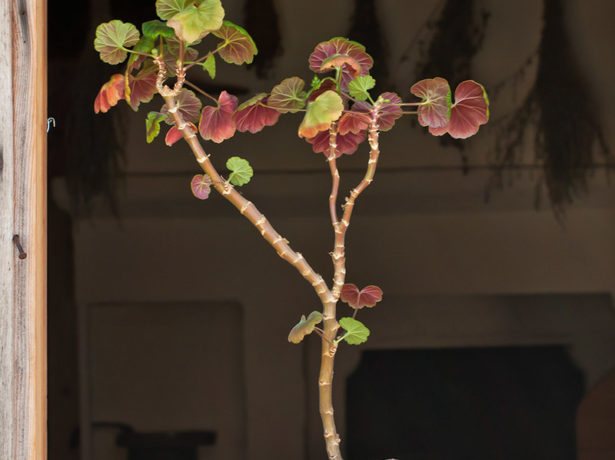

Geranium without pruning stretches up and becomes naked and ugly
If you keep the old faded geranium, then it is important not to forget that pruning is the strongest test for the plant. Therefore, it is better to carry out it with an increase in the length of daylight hours, that is, at the end of winter or early spring. Autumn pruning is worse tolerated by pelargonium and the plant may not have enough strength to recover.
What is cropping and why is it needed?
The procedure for pruning geraniums is to shorten the long shoots and remove old stems. This should be done not only in order to get new flower stalks, but also to achieve a beautiful shape for the plant. If you do not prune, the lower leaves of the plant begin to fall off, and the branches become bare, as a result of which the flower loses its beauty.
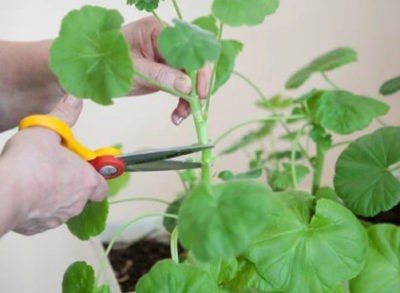

Geranium has dormant buds in almost every node, however, it is not able to give lateral processes without human help. Pruning awakens the "dormant" buds, resulting in the formation of new shoots with flower buds.
In addition, controlling the length of the shoots and the degree of growth of the bush is useful for:
- stimulation of long and abundant flowering;
- giving the plant an even compact shape;
- accelerating the metabolism in the plant and improving its quality;
- facilitating the wintering of geraniums;
- improving aeration and lighting;
- prevention of diseases.
Attention: Another advantage of pruning geraniums is that as a result the grower receives planting material in the form of new cuttings.
If the geranium bush is very large, after radical cutting of the shoots, the plant will put all its energy into the growth of new stems and leaves, because of which the inflorescences will appear late or not at all. To avoid this, for large flowers, you only need to shorten sick, long branches without leaves.
Errors when pruning geraniums at home
Pruning geraniums is not such a difficult process. The only thing that must be observed is the timeliness of its implementation. But improper pruning will lead to an unplanned result or plant death.
| Trimming errors | Possible consequences |
| Violation of the timing of pruning | Winter pruning is undesirable. Pruning the shoots during flowering will cause the buds to fall off. |
| Cropping high above the leaf node | The upper part of the stem dries up, up to its complete withering away, the aesthetic appearance of the plant is lost. |
| Pruning a large number of shoots | The plant is difficult to survive stress, does not come to its senses for a long time, does not bloom. |
| Very frequent pruning | The formation of flower buds is inhibited. |
Geranium pleases the human eye with beautiful flowers and a peculiar aroma. To create a well-groomed pelargonium bush is within the power of every grower. To do this, it is enough to prune the plant in time and provide it with proper care. Lush blooming geraniums need potassium supplementation. This is where all the secrets of creating a spherical crown or a fluffy geranium bush end. Enjoy your sight.
The specifics of pruning for different types of geranium
In addition to the classic zonal geraniums, ampel, royal, tulip geraniums, etc. are grown at home. All these plants also require the timely and correct formation of the bush.
Royal geranium
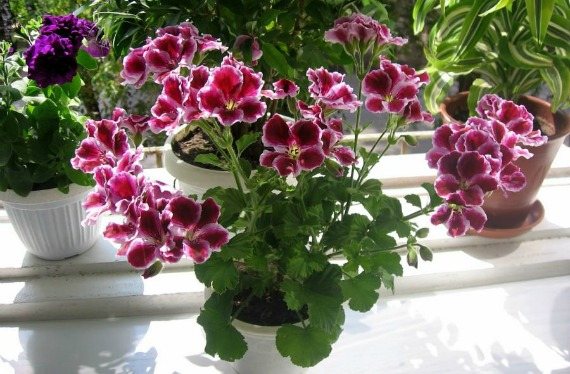

The large-flowered royal geranium is extraordinarily beautiful. Bright flowers, up to 5-7 cm in diameter, form lush caps of inflorescences of the most varied colors with obligatory blotches in the form of spots, stripes, mesh.
Simple or semi-double corollas amaze not only with their size, but also with a diverse combination of colors and shades within one petal. But such beauty requires a royal attitude towards itself and punishes the owners with the absence of flowering with improper care.
The flowering period of the royal geranium does not differ in duration, only 3-4 months per season. Therefore, compliance with the rules of maintenance and pruning for lush flowering is very important.
The main work on the formation of the crown is carried out before the plant enters a dormant period, i.e. in the middle of autumn.
- Prepare and disinfect a cutting tool (office knife, blade or ordinary knife with a thin blade).
- Visual inspection will help identify bare shoots that are trimmed over the first leaf node at the base.
- Leaves with yellowness and signs of deformation are cut off.
- The main shoot, if necessary, is shortened by a third or pinched.
December-January is the time of complete rest of the royal geranium and it is not recommended to cut it, let alone replant it. In February, it is permissible to trim one stem, if it spoils the decorative effect of the plant.
On a note. Starting from mid-March, all manipulations on the formation of the crown of the royal geranium are stopped.
Budding begins in April and by this time the plant should not think about anything other than flowering. It will be possible to start correcting the shortcomings of the aesthetic appearance of the royal geranium after flowering.
Ampel geranium
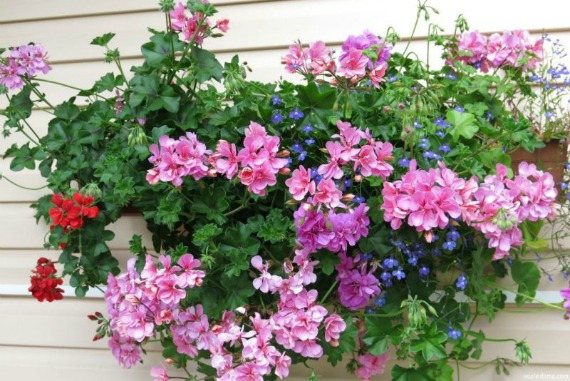

Ampelous geraniums are grown in pots, tall flowerpots or hanging baskets both in the room and outdoors. To preserve the decorative appearance and prevent thickening of the bush, autumn pruning of the plant and spring pinching of elongated shoots are required.
- After flowering, dry inflorescences are removed from the ampelous geranium and the shoots growing inside the bush are cut out.
- Cut off the shoots that have dropped the foliage over the first node at the base.
- Shorten healthy shoots 1/3 of their length for lush bloom.
Having undergone stress during the pruning process, plants require increased attention and care.
Spring pruning ivy geranium-video
Preparing pelargonium for winter
There are several options for wintering geraniums, depending on how, where and why it is grown:
- Winter storage for “street” bushes;
- Temporary relocation to a “winter apartment”;
- Preparing indoor pelargonium for winter.
Later in the article, I'll go into more detail about each of these situations.
Street geranium
Pelargonium is often used in gardening to create flower beds and decorate outdoor flowerpots. In summer, this flower perfectly tolerates changes in day and night temperatures, direct sunlight and other troubles of life in the open air. But it is not adapted to our winters, so it must be taken into the house.
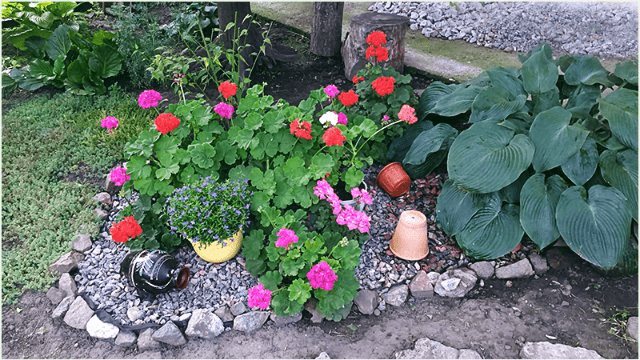

If you grow a geranium bush to decorate flower beds or garden pots and consider it only in this capacity, then the option with winter storage is suitable for you. In this case, the plant is dug up and transferred to the house for adaptation for 2 weeks. There is no need to water it at this time!
It is important to remember: you need to prepare pelargonium for winter only after the end of flowering!
After a period of habituation, the geranium is pruned. In this version, a rather radical method is used: all green shoots are removed to the lignified part. The roots can also be stripped and shortened, or left as is, along with a clod of earth - it's up to you to decide. The main thing is that in no case should excess dampness be allowed.
The remaining "stump" is carefully packed with a newspaper or put into a closed container. In this form, geraniums are left for storage in a cellar or other sufficiently dry, dark and cool place. The temperature during the winter should be kept between 4-10 ° C. In the spring, with proper care, the bush will quickly come to life and start growing.
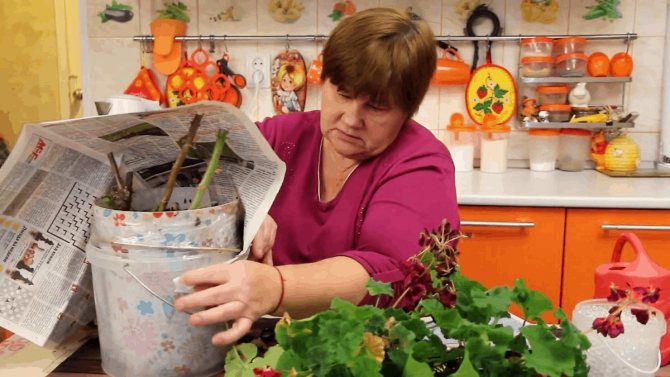

If you do not have the opportunity to leave pelargonium in the basement or cellar with appropriate conditions, it can be transferred to the category of indoor flowers for the winter. In this case, the bush is transferred into a temporary “home” pot together with an earthen lump so as not to damage the roots. Care is needed the same as for room geraniums.
Indoor geranium
Although the change of seasons in the apartment is not very noticeable, in winter pelargonium needs rest. In order for the plant to safely go into "hibernation" and gain strength before future flowering, it must be specially prepared, and later, in winter, provided with appropriate care.
The first step is pruning geraniums for the winter. It performs the following functions:
- Formation of the correct crown shape, since without leaving the pelargonium often grows unaesthetic long and weakly leafy shoots.
- Improvement and rejuvenation of the bush by removing old and diseased branches.
- Reducing nutrient consumption for the winter. Maintaining green foliage requires vitality, while the plant is weakened at this time of the year and all processes are slow.
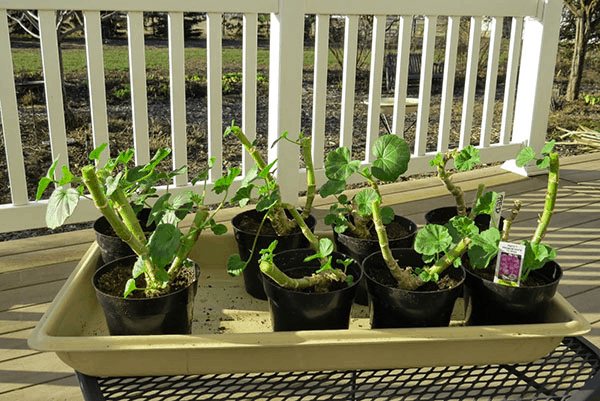

I will tell you more about the cropping rules in a separate block, now I want to mention only two important points. Firstly, this procedure can be carried out only after all the inflorescences have wither. Secondly, all types of pelargonium require varying degrees of shortening:
- Royal geranium allows you to carry out a rather radical procedure, you can significantly shorten the shoots, they will quickly recover.
- Ampel and miniature species also tolerate pruning well, but it is not necessary for them. It is carried out as needed.
- But variegated varieties react with severe stress. It is better not to touch them without strict medical indications. In the best case, you can remove wilted inflorescences and leaves.
In winter, pelargonium is displayed in the apartment in the coolest places, for example, on the windowsill. However, it is important that she does not suffer from cold drafts, they will be detrimental to the flower native to Africa.
The second important point is lighting. Although during conservation the bushes are kept in constant twilight or even in the dark, in an apartment at higher temperatures this mode is unacceptable. Geranium requires long daylight hours up to 12 hours. If necessary, phytolamps can be used.
Finally, the last important point is watering. Since the plant is in a dormant mode, and there is not so much greenery left after pruning, the need for moisture is greatly reduced. As a result, it is often watered, but little by little, so that fungal diseases do not develop in the dampness. It is better to completely exclude top dressing for this period.
Top dressing geranium
Geranium is one of those plants that like regular fertilizing with mineral fertilizers.
3 basic rules for feeding geraniums
- Fertilize geraniums from March to mid-September;
- Fertilize pelargonium once every 2 weeks;
- Before feeding, it is imperative to moisten the soil.
What fertilizers to choose for pelargonium? Any complex fertilizer for flowering plants will do. As a rule, they contain phosphorus, potassium, copper, boron, manganese, calcium, iron and nitrogen. It is important that there is little nitrogen in the composition, otherwise the growth of geranium will go into the leaves and flowering will come later. You need to feed the plant with a mineral complex according to the manufacturer's instructions.
Here are some more feeding options:
- Nitrogen fertilizers. They are good for stimulating the growth of new shoots after the plant has been pruned.
- Iodine. It is a fairly effective stimulant during the flowering period (once every 10 days), as well as a remedy for the prevention of fungal diseases. Iodine is diluted with water at the rate of 2 drops of iodine per 1 liter of water. One medium pot will require approximately 50 ml of solution. Top dressing must be poured along the walls of the pot, avoiding it getting on the roots and stem.
- Magnesium sulfate. Top dressing is carried out once a month to stimulate flowering. The solution is diluted at the rate of: 5 g of magnesium per 1.5 liters of warm water. One medium pot requires 50 ml of solution.
- Charcoal. It perfectly replaces mineral complexes, as it contains phosphorus and potassium. The solution is prepared at the rate of 1 tbsp. l. ash per 1 liter of water. The recommended dose is 100 ml per pot.
Pruning a plant in winter
In winter, it is advisable to provide peace to the grandiflora. In no case is it recommended to prune between December and January. But sometimes it grows in winter. Faced with this problem, flower growers are solving a dilemma: is it possible to cut geraniums in February if it has begun to outgrow? In rare cases, you can prune geraniums in February, but this can hardly be called a full pruning. Only one overgrown shoot is removed, which spoils the appearance of the flower too much. It is better to pinch the elongated stems rather than cut them off completely. Moreover, the last month of winter is the deadline when the room royal geranium is cut, since in April it already releases the first inflorescences. Therefore, starting from the second half of March, pinching and pruning must be stopped for a while.
You can determine exactly when to prune geraniums after winter by flower. As already noted, grandiflora blooms for a shorter period of time than normal varieties. As soon as it fades in the summer, you can begin further formation of the bush.
More about pruning pelargonium for the winter
A fairly extensive topic is pruning geraniums for the winter. The whole procedure will be described in detail in the video below, I would like to dwell on several important rules, non-observance of which personally cost me several home colors.
- First, pruning is done only in the fall or spring. From December to mid-February, this procedure cannot be carried out, because geraniums will not be able to heal wounds.
- Secondly, the cut is performed only with a sterile instrument. A sharp knife or clerical blade works best because scissors can pinch the barrel.
- Further, all large sections must be treated with disinfectants: crushed activated carbon or wood ash. Cinnamon powder is used to speed up the regeneration. If the place begins to turn black and does not heal well, it is better to make another fresh cut a little lower and re-process it.
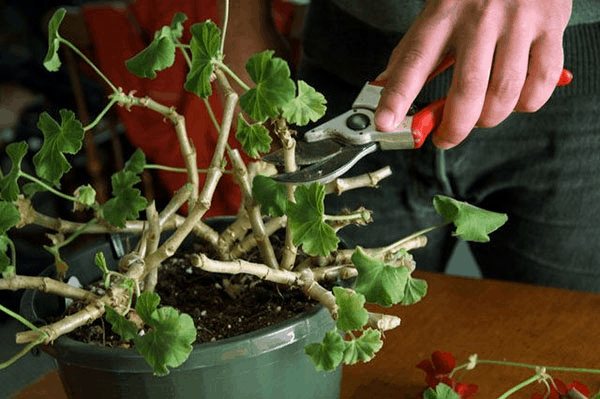

All cuttings can be rooted to get new bushes ready for planting in the spring.
You can see instructions for preparing pelargonium for winter here:
Geranium or Pelargonium is native to southern Africa. The genus has nearly 300 species. Indoor conditions most often grow pelargonium zonal, royal, Angels, ivy, fragrant and felt (mint), and in the garden - Balkan (large-rhizome), marsh, lush, etc. Since this is a southern plant, many flower growers are worried about how keep geraniums at home in winter, what to do with it in winter and whether it blooms at this time. Let's take a closer look at this in our article.
Read also Dangerous herbs for humans
Why geraniums stretch out and leaves turn yellow
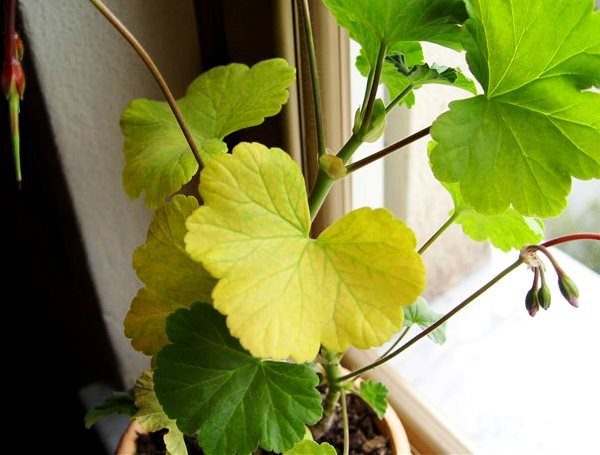

Geranium leaves are a kind of indicator. At the slightest trouble, they begin to signal the owner about the problem. For example. If the leaves start to turn yellow, then something went wrong.
Leaves can turn yellow for many reasons:
- Small pot. If the plant is already quite mature, the root system in the pot is cramped. The leaves begin to turn yellow and fall off. It is necessary to choose the size of the pot, but here again you must not miss. If you take a pot larger than necessary, then the flowers will have to wait until the roots are distributed throughout the earth.
- If the root system is damaged during transplantation, yellow foliage is also observed.
- Leaves turn yellow and rotten places appear with excessive moisture. With a large lesion, geraniums must be transplanted into another soil by treating the roots with a fungicide or a weak solution of potassium permanganate.
- If the lower leaves turn yellow and dry areas appear on them, this indicates that the plant has little moisture.
- With a shortage of mineral fertilizers, the leaves also signal yellow. But such a geranium is a flower that an excess of fertilizer will also negatively affect the color of the foliage.
- Leaves turn yellow even with very dense soil. You need to change the ground.
- Yellow leaves will appear both from direct sunlight and from too shade. And also when the plant is in a draft.
Wintering of large-flowered pelargonium
Large-flowered geraniums should not go through a pronounced dormant period like zoned pelargoniums and can be stored at higher temperatures. In order for them to bloom again in spring, they must be stored in a well-lit room with a temperature of 12-14 ° C, but no more! In such conditions, they will grow all the time. They need 2 months to create new flower buds.
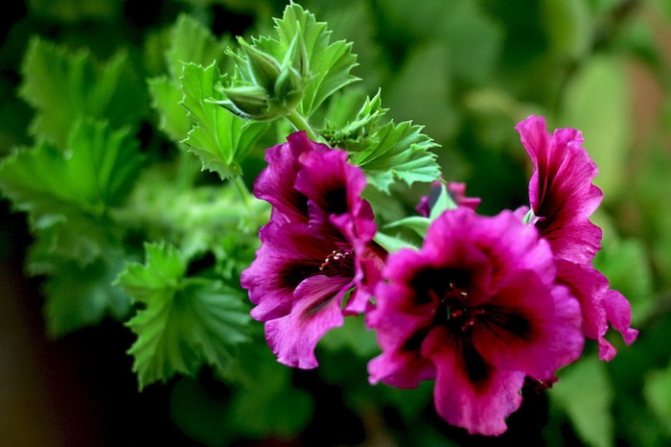

When you notice the first buds, you need to raise the temperature to 18 ° C. Thanks to these conditions of winter keeping, geraniums will bloom in April. If for some reason you cannot provide the plant with the above conditions, it is necessary to overwinter geraniums in the same way as the previous zonal pelargonium. Then the plant will remain dormant. It will not harm them, they will just bloom a little later.
Rescued geranium
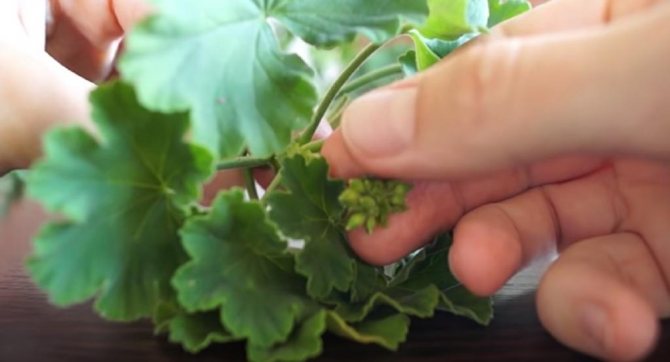

My neighbor, once stopping by to visit me, found such a poor fellow, languishing in the corner by the window. She is known here as an experienced florist. This is someone who bloomed and overgrown with lush greenery everything that fell into her caring hands. The neighbor asked why this flower looks strange and what am I going to do with it like that? At that time, I secretly hoped that this stick would finally die and I could, without a twinge of conscience, take the remains of the unfortunate plant to the trash. She decided not to hide her thoughts from her neighbor and answered frankly.
Sleep improves metabolism. Scientists have explained why a person needs to sleep
The company organizes gastronomic tours introducing culinary traditions
The owner loves to comb his chinchilla's fur: she loves it no less
Her gaze flashed interest, pity for the plant and kindness. Yes, she is known for her gentle nature. My neighbor asked me to give her this geranium and promised to make a real beauty out of her, which she would return to me literally in the spring. I, shall we say, spared my pelargonium and gave it to the one who really had a geranium that had a chance of survival. Yes, and there is always little space on the windowsills on the eve of winter, but it is necessary to accommodate other plants, not so capricious (as I thought at that moment).
How to keep geraniums in your basement in winter
Some geranium lovers plant it in the garden for the whole summer. Before the winter cold, they have a problem of how to preserve garden geraniums.
Read also Two wires black and white which is a plus
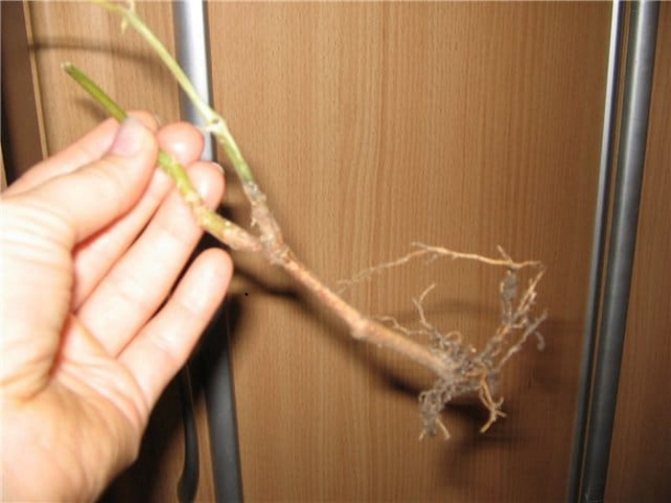

There are several ways to store geraniums in a basement:
- Pelargonium bunches are hung in the basement at a constant temperature of 2 to 7 degrees above zero. Some growers, instead of hanging them, wrap the plants in newspaper or put them in paper bags. In this case, you need to ensure that the bags are open for ventilation. Plant roots are periodically moisturized. This method is called "dry storage".
- Geraniums are planted in pots, before that the roots and stems are cut by two-thirds. The prepared plant is stored in the basement at a constant temperature of up to 10 degrees, the room should be twilight. Pelargonium planted in this way is watered infrequently, only when the soil becomes dry. This way of storing geraniums is called "canning".
Of course, not every basement is suitable for wintering your pets. Several conditions must be met:
- The room must be frost-free and dry.
- Temperature range - within +7 degrees.
- It is good if natural light is supported by the presence of a small window.
- Geranium must be pruned (all flowers and leaves are removed, only woody parts of the plants remain).
Temperature conditions, degree of illumination, air humidity in all basements are different. Therefore, in order to understand which method will help to effectively preserve most of the plants in your case, you need to try them all.Regardless of which storage method you choose for your plants, make sure the frost hazard is over before planting them outside. Then a lush bloom will be guaranteed throughout the next season.
Geranium propagation
The tops of geraniums remaining after trimming can be used for its propagation. Cuttings take root best in spring, but good results can also be obtained in autumn.
- Propagating geraniums by cuttings is the easiest and fastest way to replenish your flower collection. In the first summer after rooting, young plants will bloom and retain all the properties of the mother flower.
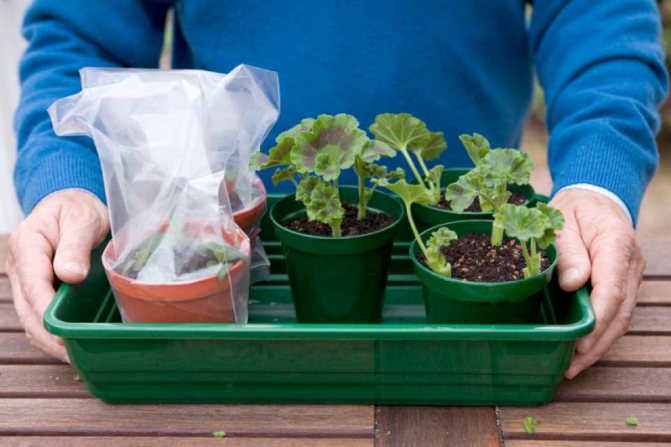

So how to propagate geraniums and root cuttings? After you have pruned the geraniums, select young shoots from the "scraps", the stems of which did not have time to wood. If the cut is long, then you can divide it into 2-3 shoots 10-15 cm long. Now the shoots need to be rooted in water or in the ground. The second method is the most reliable. Here's a step-by-step guide on how to root a Pelargonium stalk with a 99% success rate.
Rooting the cuttings of geraniums by planting in the ground
- Cut off the stalk under the bud, then break off or cut off the bottom two or three leaves.
- We leave the cutting alone for 5 minutes, so that its base dries a little.
- Put a layer of drainage 1.5-2 cm thick in a prepared pot with drainage holes.
- Next, fill the soil into the pot by about 2/3. What kind of substrate is right? You can take a ready-made universal soil for flowering indoor plants or prepare a soil mixture yourself according to the following recipe: sod land 50%, sand 30%, peat 20%.
- In the center of the soil, using a pencil, make a hole, plant a stalk into it to a depth of 5 cm and compact it with earth.
- Water the stalk with a solution of some fungicide, for example, Fitosporin (diluted at the rate of 15 drops per 1 liter of water to make the composition the color of tea brew), then add a couple more handfuls of soil and tamp it slightly.
- We put a plastic bag on the pot and leave it for 3 weeks in a place with sufficient lighting.
The first fertilizing can be done no earlier than 3 months after planting the cuttings.
Rooting geranium cuttings in water is easier but less effective. Here's a step-by-step guide:
- Pour about 100 ml of water (settled or filtered) into a small container;
- Lower the base of the cutting into water to a depth of no more than 1.5-2 cm. Deeper immersion is fraught with decay;
- Put a couple of activated charcoal tablets in a glass;
- Place the cup with the handle in a place with sufficient lighting, but not in direct sunlight;
- Change the water once a week. If it evaporates quickly, periodically add water to the glass. After about 10 days, you will see the first roots;
- After about 45-50 days (but no more), when the roots grow up to 2.5-3 cm, transplant the cutting into a pot of soil according to the instructions for transplanting geraniums later in the article.
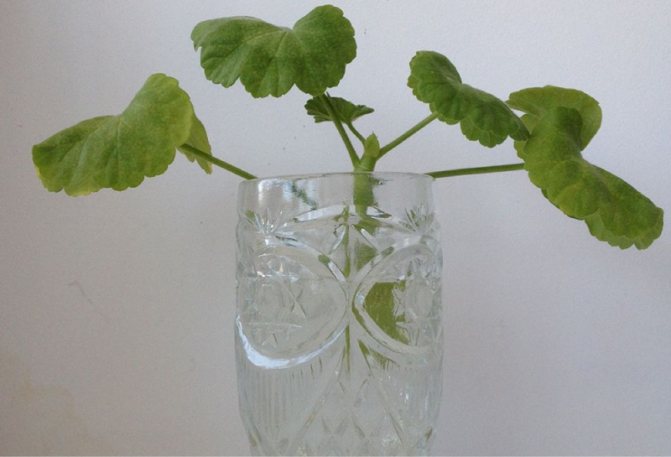

Best time to prune geraniums
There are many opinions about when to prune geraniums - in spring or autumn, what time of the year is best for this? It is difficult to unequivocally answer this question, since everything depends on many factors: the variety, the condition of the plant, its age, the purpose of pruning.
In general, flower growers and gardeners believe that shrubs need to be formed regularly, as needed. It arises especially sharply when the shoots begin to stretch too much, lose foliage and, accordingly, external attractiveness. Basically, these are cosmetic pinching of the apical parts.
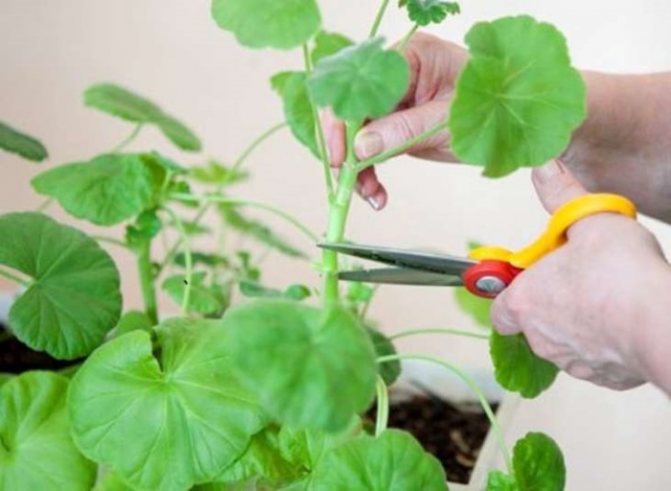

The main benefits of a haircut are as follows:
- prolongation of flowering time;
- ensuring a better metabolism of nutrients;
- the formation of lateral shoots;
- preparation for the wintering process.
Deeper pruning should be done once or twice a year, depending on how fast the flower is growing.At the same time, a natural question arises, when is it better to cut geraniums: in autumn or spring, if cardinal regulation of its growth is planned? The most suitable time for this procedure is autumn.
How to prepare geraniums for winter in an apartment
Glazed loggia or insulated balcony
Most of the pelargoniums overwinter on a glazed loggia, where the air temperature does not drop below + 12 ° C on frosty winter nights. In such almost ideal conditions, some of the plants continue to bloom (not as luxuriantly as in summer) for most of the winter. Some pots with bushes are placed in hanging baskets and pots, others I put on tables and a ladder for plants. This option allows you to get by with corrective pruning in the fall and more radical in late February - early March.
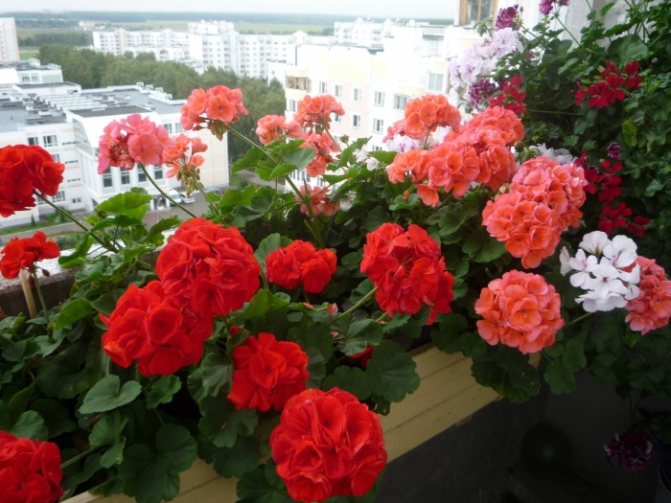

Watering is moderate. No top dressing. With such a content, pelargoniums bloom for a long time, and by spring they themselves go into "standby mode". The buds hardly open, allowing the plant to rest and accumulate strength. Part of the leaves periodically dries up.
Window sill
There are no problems with growing pelargonium on the windowsill. The main thing is to find a place for them. Pots or boxes are placed on foam sheets or packing troughs so as not to chill the root system. The danger is posed by open vents and transoms on frosty days. It is bad if the battery is burning nearby. Autumn pruning when grown on a windowsill is sparing, since pelargoniums do not go into hibernation and continue to bloom. But a strong spring pruning is necessary. Care comes down to a fairly rare watering, cleaning of dried leaves and peduncles and pest control.
Frost-proof garage and staircase
Many amateur gardeners I know keep flowerpots, boxes and large pots of pelargoniums in frost-free garages and stairwells in winter. Before this, the plants are strongly pruned, leaving parts with a height of 15 - 20 cm. Large branches are shortened, but not removed. It is watered several times during the winter, very sparingly, only so that the ground with the roots does not dry out.
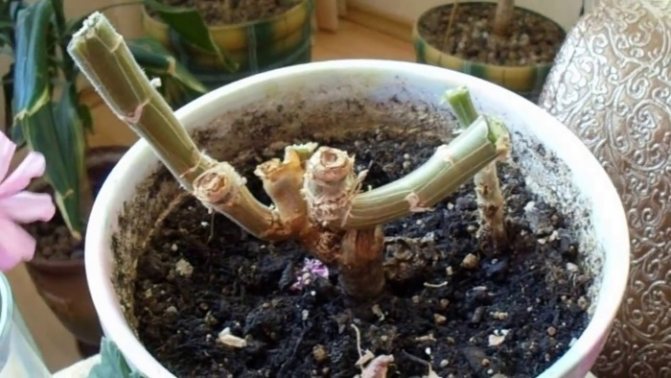

Refrigerator
When storing pelargonium in the refrigerator (on the top shelf, shelves on the door, in vegetable drawers), you must first work with the bushes. In dry weather at the end of September or in October (for weather and life circumstances), pelargoniums are removed from the soil along with the root system. After that, most of the roots are carefully cut off, leaving a root ball with soil (about 8-10 cm).
This lump does not need to be moisturized, it is better if it is dry enough. It is wrapped in foil so that the earth does not spill out. Pelargonium is cut off, leaving a stump from the ground part of such a size that two plants fit in a liter bag of juice or milk. The package is wrapped in a newspaper folded in several parts. The condition of the stored pelargonium is checked from time to time. Look to see if the paper is wet. In February, pelargoniums are taken out, planted in containers and start germination.
"Head down"
There are many other options for preserving pelargonium brought from the site to the house. Among them, attention is drawn to the hanging of the bush "upside down", when a lump of shortened roots with soil or peat is packed in a plastic bag, tightly tied and hung from a hook or shelf in a cool place (for example, in the basement). The ground part is also greatly shortened. Experts consider this unusual option for wintering pelargoniums to be very effective and guaranteeing lush flowering for the next year.
Old gardeners say it would be a good idea to sprinkle sulfur powder on the roots to keep the roots from rotting.
At the end of winter, geraniums are transferred from the basement, pulled out of paper and the rotten roots are cut off. After that, they are planted in fresh, moist soil. Watering is necessary only when the first leaves appear on the stems.
What to do after autumn pruning
Pots with cut geraniums are stored until January or February in cool places, with very limited watering or no watering at all.
Why until January or February. December is the month when the light duration of day and night is compared, this is the time of the astronomical winter. Geraniums lack natural light in such a short period and they sleep. After the day of the winter equinox, daylight hours begin to increase. By January, daylight hours will be enough to awaken dormant kidneys. Therefore, the pots are brought out into the light and in the warmth and slowly begin to water. Water sparingly, remembering that as long as there are no large leaves, the plant will not be able to evaporate moisture.
Where are the pots stored?
- In a dark cold basement at a temperature of 0-10 degrees, without watering
- On a cold veranda without watering
- In a room, on a cold windowsill. In this case, you need to water a little, because the air in the room is very dry. Once a month is enough.
Pruned cuttings can be rooted in pots, just put in water to take root (you will not believe, but this method works, by spring many cuttings will have excellent roots), or put in vases at home for beauty, especially since pruning takes place on still flowering streamers.
In January, when the day lengthens, the pots are brought into heat and watered, after having pierced a clod of earth in several places.
This geranium was brought from the basement in January
The shoots of such an overwintered geranium (it is called a mother plant) are used as cuttings for propagation or left to bloom on their root.


What to do to make the flower fluffy?
Good condition and rapid flowering of geraniums depend on the quality of pruning,
therefore, pruning is carried out with a sharp blade or knife, which must be necessarily disinfected, the algorithm is as follows:
- Experienced growers advise pruning with a sharp blade or utility knife. You should not use scissors, since during this process the stem is pinched and receives additional injuries in the form of cracks.
- The cut is made over the node from which the leaf is growing, facing outward - if the leaves are turned inside the bush, then the shoots will interfere, grow each other, while the density of the plant will be increased, and this may cause diseases and insects.
- If you need to remove a young shoot, you can simply pinch it gently with clean, dry hands directly from the main stem, being careful not to damage the main layer.
- Be sure to treat the cuts, otherwise the plant may rot. You can apply crushed coal, cinnamon or plain brilliant green.
If you want geranium to make a large distillation of greens after pruning, then it is worth feeding it with nitrogen fertilizer.
How is spring pruning done?
There is a lot of controversy over whether to prune geraniums in the spring. But the controversy boils down to the following: to decide when to prune geraniums in spring, and whether it is worth doing at all, must be decided by each grower for a particular flower on an individual basis. During the winter period, the plant could grow strongly, especially if the conditions necessary for "rest" were not met.
If this happens, then the plant needs spring pruning. True, after it, flowering will begin later, but it will not be inferior in quality. For an experienced grower, it is not a big secret when to prune geraniums in spring - the timing suitable for this operation is the last days of February - the first two weeks of March. This is the period when it is high time to cut geraniums into cuttings in the spring, since it is not recommended to carry out activities for pruning shoots later.
Pruning in spring is not as drastic as pruning in fall. Basically, overgrown shoots are pinched so that the plant spends its energy on laying lateral buds, from which new stems and peduncles will grow in the future.
If all the necessary requirements for ensuring winter rest have been met, then deep autumn pruning will be enough.In the spring, the plant will wake up from winter sleep and begin to actively pick up buds. All the rules for carrying out spring pruning completely coincide with the methods of plant formation in the fall.
King geranium - pruning features
The pruning technique described above is suitable for most varieties of unpretentious zoned geraniums. But there are flower varieties that are more demanding in care, including pruning. These include grandiflora or royal geranium. It blooms with unusually beautiful, and most importantly large flowers, therefore it is often called large-flowered geranium. One flower in diameter can reach from 5 to 7 cm. But their decorativeness does not end there, as often the petals are corrugated, and the colors are simply striking in their variety. You will not find monochromatic flowers on this type of plant. They are always decorated with some kind of specks, rims, stripes. Outwardly, they strongly resemble petunia.
But such beauty is not complete without flaws. The main ones are the exactingness of care and a short flowering period. If ordinary, zonal geraniums can bloom almost all year round, then grandiflora will delight with its inflorescences only 3-4 months per season. This will only happen with proper care. Knowing its capricious nature, the owners of the flower are interested in how to cut the royal geranium so that in the spring the wayward beauty will fully demonstrate all the varietal qualities inherent in it. The first step is to decide when to transplant and cut large-flowered geraniums - in autumn or spring. In this case, only the autumn period is suitable for pruning. Two problems are solved at once - the bush is preparing for wintering and material is being collected for further cultivation of the variety - cuttings.
The procedure for pruning geranium
Before pruning geraniums to bloom, it is necessary to disinfect the tool that will cut the stems. Keep your scissors, garden knife, or pruner sharp to get an even cut. Further, all obsolete parts of the plant and leaves are cut off. Leafless shoots are removed at the root, in front of the very first node from the ground. The same should be done with shoots that are too elongated. Then they begin to trim the main shoot. It is cut by a third, since it is possible to cut geraniums for abundant and lush flowering only by sacrificing just such a part of the stems and leaves.
Alternative way of content
For residents of an apartment, it is often an insoluble problem to provide a cool room for their favorite pelargonium. Empirically, another method was invented. The plant overwinters in the room, as close to the windows as possible, and with the onset of spring, as soon as the air temperature rises to +2, start taking the pots out to the balcony. First, take out for 2 hours, and then gradually increase the time in the cold. This option will provide excellent geranium flowering. In principle, the plant is unpretentious, which means it can bloom without such tricks, but no one will give you a 100% guarantee.
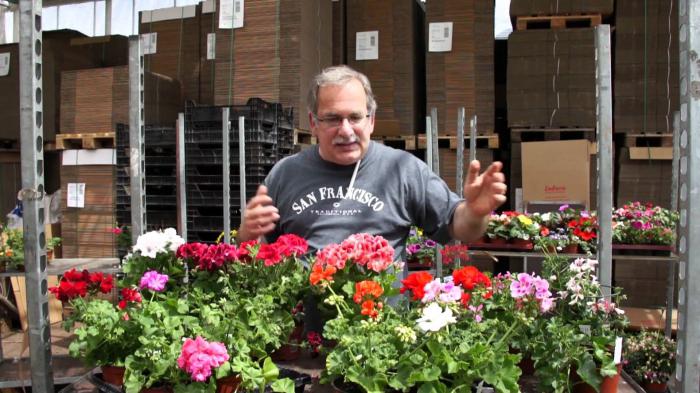

How to welcome spring
Closer to spring, when the temperature outside will reach 2 degrees above zero, you can take the pelargonium pots to the balcony. You need to start with half an hour, gradually increasing the residence time of the geranium on the balcony. This way you can help the pelargonium bloom constantly.
- If the geranium was stored in the basement, then you need to soak the bundles in water with fertilizer before taking it out into the street, then plant it in a pot.
- The potted geranium should be kept indoors for about a week. Only after the onset of the last frost is pelargonium planted in a garden flower garden.
Thus, geraniums should be placed in a cool room in winter, provide additional lighting and monitor soil moisture. You also need to break off dried leaves and peduncles from time to time.Subject to all these simple rules of pelargonium, we will delight with our flowering and aroma immediately after leaving the rest phase.
Examine the plants every month to see if they are getting too dry and wrinkled. Spray suspended plants with water if necessary. If the geraniums become so dry that the stems begin to shrink, remove them from the bags and soak the roots for an hour or two in cool water. After soaking in water, let them dry before placing them in paper bags. Do this several times during the winter to keep the plants from drying out. For plants that have wintered, it may take several weeks to start growing again in the spring.
Topping
Before pinching geraniums, you need to find the largest upper bud on the stem, which is responsible for the growing season. You can pinch it off with your fingers, carefully separating it from the shoot. A tightly seated bud can be pinched off with a garden pruner.
On a note. Flowering usually begins in May. A pinch of geranium is the reason that the culture begins to bloom later than usual (in May). This is due to the fact that nutrients are consumed in the formation of lateral processes.
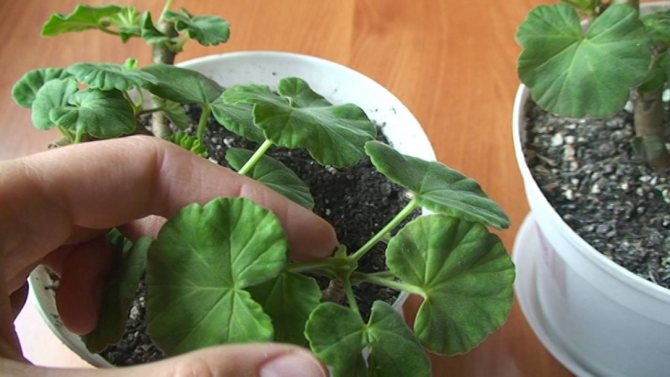

Pinching geraniums
Home geranium care, disease and treatment
Many diseases and parasites bypass geraniums, but there are pests that do not care about its peculiar smell. Most often, the whitefly settles on pelargonium. If there are few parasites, then the plant is treated with soapy water and covered with a film, but if the damage is serious, then you will have to resort to chemicals, of which there are a lot on sale. Appear on geraniums and spider mites. You can fight them only with the use of special drugs.
A fungal disease that is very common on this plant is the so-called black leg. It affects both young and adult plants, and the reason for its appearance is waterlogging and poor drainage system.
My way to keep balcony geraniums in the house in winter
Every year before the onset of cold weather, and we have it in October or November, I bring my geraniums into the house. It's not easy, because I have about 40 bushes. Therefore, I bring them in not for flowering, but for wintering.
They hibernate in a compact form. I transfer several bushes into a couple of three large pots so that they do not take up much space and put them "in the far corner." Previously, the far corner was a wide window sill behind the curtain. And now it is a large shelf in the corner of the insulated balcony. It is not very bright and not very warm there.
Unfortunately, I don’t have a cold dark basement and I don’t have wide illuminated windowsills. And I don't want to put it under the bed, as my great-grandmother did, and the beds themselves have changed a lot since then.
Since there are a lot of flowers, I do not bring in all, but only those that I definitely want to leave as a mother plant to obtain planting material by the spring. And from the rest I take cuttings and distribute them to neighbors, or simply put them in jars of water. It sounds rather strange to leave the shoots in the water until spring, but it works for me. By the spring, some shoots are producing large roots, and I plant ready cuttings with roots.
In the "far corner" I water the plants once a month. And so on until January. In January, I start watering once a week. Young shoots become plump, I use them as cuttings for seedlings, later they will give a good lush flowering. And also I divide the entire long stem into cuttings and root them too. Read more about this in the article. Geranium propagation.
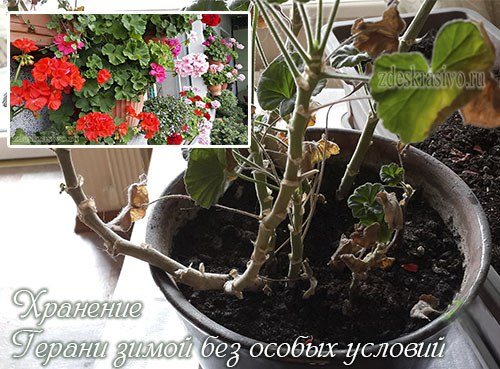

Basically, I am applying spring pruning geraniums.
Let's sum up
As you can see, caring for home geraniums is not difficult at all. Diseases, reproduction, watering and feeding - what causes so many difficulties for growers when breeding capricious tropical flowers is not a problem when growing pelargonium.The care is intuitively simple, the drugs for the treatment are freely sold on sale. The only moment that can cause some difficulty is pruning and forming a beautiful bush. For the first time, it is better to resort to the help of an experienced grower.
Care
Care after trimming should be more thorough,
so that the plant has the strength to recover. Geranium is placed in a room with a temperature of + 15-18 degrees, the number of watering is reduced to a minimum so that the flower does not rot. In this case, the lighting should be maximum, but without direct sunlight. For the growth of a large amount of greenery, fertilizing with nitrogen fertilizers is carried out.
As soon as the wounds from the cuts are tightened, you can move the plant to a warmer room, it is better to install a flowerpot with geraniums on the southern windowsill, or equip additional lighting.
It must be remembered that geranium is a light-loving plant that does not tolerate heat and stuffiness, therefore the room in which it stands must be constantly ventilated.
Constantly pruning pelargonium is necessary not only for the formation of a bush.
If excess, dried out and unhealthy processes are removed, a free space is formed. The thinned bush is well ventilated, the threat of infection with fungal diseases is significantly reduced. The appearance of the plant becomes the most accurate and attractive. The mass of greenery becomes small, while the number of inflorescences and their quality increase.
Transplant and soil
A transplant is always stressful for geraniums. It is needed only in case of root overgrowth or if you urgently need to save the plant from overflow. After the purchase, replanting pelargonium is especially risky, since it needs at least a month to adapt.
- In any case, you can only transplant geraniums in spring and summer. In winter, the transplanted plant may not take root in the new soil.
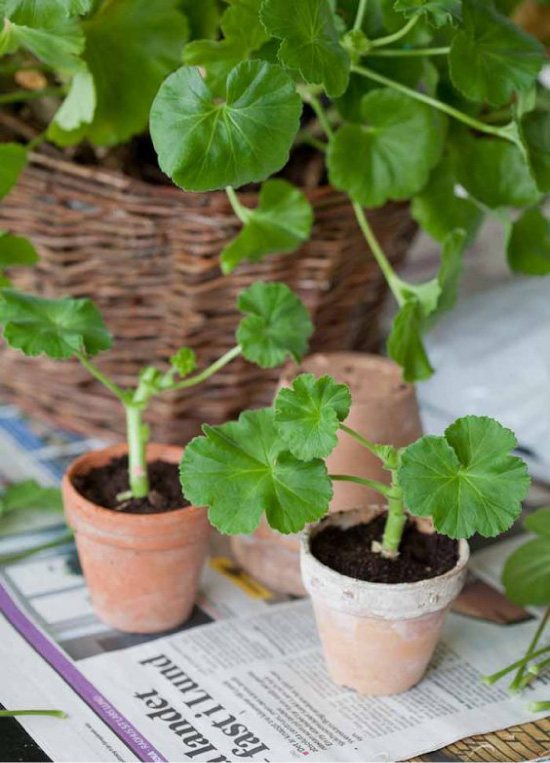

How to transplant geraniums?
First, make sure that her peduncles have not begun to bloom, otherwise they just need to be broken off or postponed until the end of flowering. Then follow this step by step instructions:
- Pick up a new pot slightly larger than the old one;
- Prepare the soil for transplanting geraniums. It should be loose, well-drained, and neutral in acidity. A universal substrate for flowering indoor plants is suitable;
- Pour a layer of drainage 1.5-2 cm thick at the bottom of the pot.
Dip the geranium into a new pot, along with the old earthen clod (or without it, if the plant is flooded) to such a depth that the trunk is hidden in the ground, and only the center of the bush remains visible on the surface. Keeping the plant up and running, start pouring soil into the pot. After the first two handfuls of soil, you can add a long-acting universal fertilizer such as Osmocote or DuraTec at the rate of 3 g per 1 liter pot.
Watering
Water for irrigation should be filtered or settled, always at room temperature or slightly warm. Cold water can cause root rot.
How often to water geraniums?
In winter and autumn, watering should be reduced to 1 time in 10-14 days.
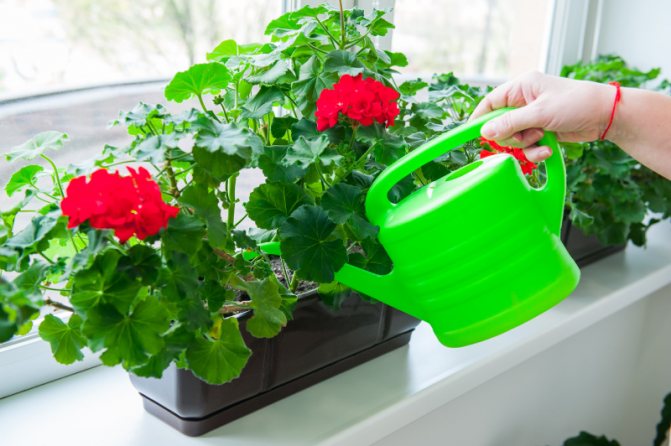

Remember that Pelargonium, as a South African, is a dry plant, has the ability to store moisture, and tolerates underfilling better than overflow. For this reason, it is undesirable to spray and wash geranium leaves, otherwise they may turn yellow. At the same time, yellowing of the leaves can cause a lack of moisture.
- It is important to ensure that no water stagnates in the pot pan after watering. Also make sure there are large drainage holes in the bottom of the geranium pot.
Spring care
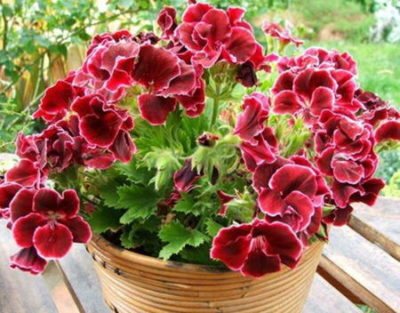

At the beginning of March, geraniums begin to wake up gradually in order to intensively spend their strength, accumulated over their entire dormant period. For this, the temperature in the room where the flower is located gradually increases.If he was on the balcony, then he can simply be brought into the apartment, and the room temperature is quite suitable for the entire growing season.
In spring, a rule works for this plant, which sounds like this: "the more light, the better!" therefore a pot of geraniums is placed on the lightest windowsill in the apartment, and it doesn't matter at all whether scattered or direct sunlight gets there. Only on those days when the sun is especially scorching, the plant can be covered with something.

